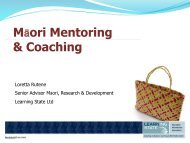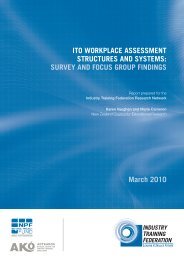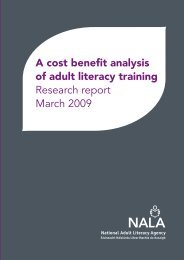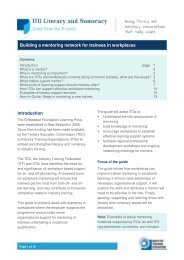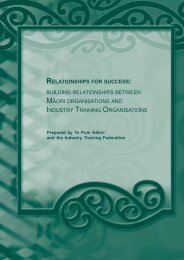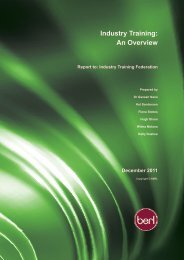iTO lEADErShip in AcTiOn - Industry Training Federation
iTO lEADErShip in AcTiOn - Industry Training Federation
iTO lEADErShip in AcTiOn - Industry Training Federation
Create successful ePaper yourself
Turn your PDF publications into a flip-book with our unique Google optimized e-Paper software.
CONTENTSCIntroductioniiiLabour Market Forecast<strong>in</strong>g 1ESITO Skills Forecast<strong>in</strong>g 2Oil and Gas Skills Action Plan 3Sports Turf ITO – Future Skills Project 4Workforce Development 6Skills for Wellbe<strong>in</strong>g, 2020 7Skills Active Aotearoa National Snowsports Certificate 9Skill And Labour Shortages 11Truck Drivers Cadetship Programme 12EventStarNZ© 13Bcito Solid Plaster Master Class 14Skills And Productivity 15Lean Mar<strong>in</strong>e Th<strong>in</strong>k<strong>in</strong>g 16Clelands Timber – Competitive Manufactur<strong>in</strong>g 17InfraTra<strong>in</strong> – Research <strong>in</strong>to the Drivers of Productivity 18Pathways And Careers 19Social Services ITO National Degrees 20Attto/Hsi NZSkillsConnect Website 21Retail Institute National Certificate for Supermarkets 23InfraTra<strong>in</strong> National Diploma <strong>in</strong> Civil Eng<strong>in</strong>eer<strong>in</strong>g 24Work and Income Cadet Programme 25Secondary Schools 26New Zealand Careers Roadshow 27Etito Bright Sparks Programme 28BETA BConstructive Programme 29Under-Representation 30InfraTra<strong>in</strong> Māori Tra<strong>in</strong><strong>in</strong>g Initiative 31Esito Women Workers Responsiveness Project 32Nzhito Pacific Foundation Programme <strong>in</strong> Horticulture 33Management 35Floor<strong>in</strong>g <strong>Industry</strong> Management Research 36Farm<strong>in</strong>g to Succeed 37Language, Literacy And Numeracy 38Embedded Literacy – Careerforce ITO 39Plumb<strong>in</strong>g, Gasfitt<strong>in</strong>g, Dra<strong>in</strong>lay<strong>in</strong>g and Roof<strong>in</strong>g ITO 41ATTTO Literacy Project for Aviation Ramp Operators 42i
LABOUR MARKET FORECASTING1Sports Turf ITO – Future Skills ProjectThe NZ Sports Turf ITO (STITO) has beenlead<strong>in</strong>g its <strong>in</strong>dustry through several researchand <strong>in</strong>dustry consultation processes over thepast five years around its Sports Turf FutureSkills project. The outcome of this work willbe the publication of the Sports Turf StrategicTra<strong>in</strong><strong>in</strong>g Plan <strong>in</strong> 2010, which will <strong>in</strong>form the2011-2013 Investment Plan process.The Sports Turf Future Skills project began<strong>in</strong> 2006 with an <strong>in</strong>dustry survey and futureskills analysis. In the follow<strong>in</strong>g year STITOundertook an analysis of Census data tobuild on the research project and exam<strong>in</strong>esector employment trends. 2008 saw thedevelopment of a draft strategic tra<strong>in</strong><strong>in</strong>g planstrategy <strong>in</strong> consultation with the sports turf<strong>in</strong>dustry. In 2009 this draft was presentedto the NZ Turf Conference, where delegateswere also surveyed about the direction ofthe strategy. 2010 will see the results of thisproject and the publication of the Sports TurfStrategic Tra<strong>in</strong><strong>in</strong>g Plan.In 2006, as part of the NZ Sports Turf<strong>Industry</strong> Survey and Future Skills AnalysisProject, <strong>in</strong>dustry sectors were surveyed todeterm<strong>in</strong>e their economic characteristicsand assess workforce skills and tra<strong>in</strong><strong>in</strong>gneeds. The survey found the number ofpeople employed by the sports turf <strong>in</strong>dustrywas significantly higher than that previouslysurveyed. Based on these f<strong>in</strong>d<strong>in</strong>gs, a numberof recommendations were made for theadvancement of tra<strong>in</strong><strong>in</strong>g with<strong>in</strong> the <strong>in</strong>dustry.NZIER (a strategic consult<strong>in</strong>g firm) wasengaged by STITO <strong>in</strong> 2007 to confirm thesize and scope of the sports turf <strong>in</strong>dustryby analys<strong>in</strong>g Census data. This study builton the previous skills analysis project andexam<strong>in</strong>ed both the profile and employmenttrends of sports turf <strong>in</strong>dustry occupations.The result was a description of theoccupations of the sports turf workforce atthe time, which enabled useful comparisonswith the general workforce.4
1LABOUR MARKET FORECASTINGThe project was developed further <strong>in</strong>2008 us<strong>in</strong>g fund<strong>in</strong>g from the TEC SectorLeadership Fund with the productionof a Draft Strategic Tra<strong>in</strong><strong>in</strong>g Strategy <strong>in</strong>consultation with <strong>in</strong>dustry. The strategicplann<strong>in</strong>g process <strong>in</strong>volved the identificationof what must be done differently <strong>in</strong> the skillsand tra<strong>in</strong><strong>in</strong>g area to improve the <strong>in</strong>dustry’slong-term economic performance. Therewas also a consensus reached on themost important issues and risks fac<strong>in</strong>g the<strong>in</strong>dustry and the development of strategiesfor address<strong>in</strong>g them.STITO presented the draft strategy at the2009 NZ Turf Conference and a survey ofdelegates substantially confirmed the issuesidentified <strong>in</strong> STITO’s earlier research work,and endorsed the direction of the strategictra<strong>in</strong><strong>in</strong>g plan strategy and its proposedimplementation process.Dur<strong>in</strong>g 2010, MWB Consultancy Ltd hasbeen engaged to analyse and synthesise<strong>in</strong>formation compiled, carry out a gapanalysis to identify additional developmentrequirements and activities, and to completethe Sports Turf Strategic Tra<strong>in</strong><strong>in</strong>g Plan.Subsequent development work carried outdur<strong>in</strong>g 2010 has <strong>in</strong>cluded <strong>in</strong>terviews withNational Sports Organisations and other key<strong>in</strong>dustry stakeholders to verify and update<strong>in</strong>formation, further analysis of 2006 surveysource data, analysis of recent labour marketand educational data, and the formulationof a Sports Turf <strong>Industry</strong> Qualifications andCareers Pathway.The Sports Turf Strategic Tra<strong>in</strong><strong>in</strong>g Plan willbe used by a range of audiences <strong>in</strong>clud<strong>in</strong>g<strong>in</strong>dustry, tertiary education providers,and Government. It will provide the userswith an outl<strong>in</strong>e of the sports turf <strong>in</strong>dustry,its characteristics (<strong>in</strong>dustry, labour andeconomic), issues and trends, currentand future skill development needs andthe identification of priorities for futuredevelopment <strong>in</strong> a summary of key messages.“This project has been valuable to confirmwhat the ITO needs to focus on over thenext 3 -5 years <strong>in</strong> its leadership role, as itworks alongside <strong>in</strong>dustry to develop skilllevels <strong>in</strong> the workforce”. (Jenny Lupton – ITOExecutive Officer).www.nzstito.org.nz5
WORKFORCE DEVELOPMENT2Industries <strong>in</strong> New Zealand need to adaptover time to deal with changes <strong>in</strong> the waythey operate, or to respond to particularworkforce issues. In such cases ITOs workwith their <strong>in</strong>dustries to help develop the<strong>in</strong>dustry workforce to respond to thesechanges, or to best meet the unique needsof the <strong>in</strong>dustry. Workforce challenges maybe caused by changes driven from with<strong>in</strong> thesector or externally, or stem from particularunique characteristics of the sector.Sectors can have particular characteristicsthat mean they need to tra<strong>in</strong> their workforce<strong>in</strong> a different way from many other <strong>in</strong>dustries.For example, if an <strong>in</strong>dustry is highly seasonalor transient it will have different tra<strong>in</strong><strong>in</strong>g needsthan one with a more stable or year-roundworkforce.Industries can also face large changes drivenby the <strong>in</strong>dustry itself. In these cases an<strong>in</strong>dustry may have a vision for where it wantsto go <strong>in</strong> the future. ITOs play a role <strong>in</strong> help<strong>in</strong>gthe <strong>in</strong>dustry consider skill needs and tra<strong>in</strong><strong>in</strong>grequirements to meet their future vision.Other <strong>in</strong>dustries face sizable changes drivenby factors beyond their control. For example,one particular issue that will have an impacton many New Zealand <strong>in</strong>dustries over thecom<strong>in</strong>g years is the effect of climate changeand the differences this will make to workpractices. In such cases ITOs need to workwith <strong>in</strong>dustries to upskill workers to dealwith change before or as it happens so thatbus<strong>in</strong>esses can rema<strong>in</strong> productive and the<strong>in</strong>dustry can rema<strong>in</strong> viable.6
2WORKFORCE DEVELOPMENTSkills for Wellbe<strong>in</strong>g, 2020Skills for Wellbe<strong>in</strong>g, 2020 is the workforcedevelopment project for social servicescurrently be<strong>in</strong>g developed by the socialservices <strong>in</strong>dustry and the Social Services<strong>Industry</strong> Tra<strong>in</strong><strong>in</strong>g Organisation. Sector leadersfrom social services and voluntary welfareumbrella organisations are collaborat<strong>in</strong>gwith the Social Services ITO on the project,with fund<strong>in</strong>g from the Tertiary EducationCommission.The project is <strong>in</strong>tended to provide avision-driven framework for strengthen<strong>in</strong>gand develop<strong>in</strong>g the social services andcommunity sector to effectively contributeto the susta<strong>in</strong>able wellbe<strong>in</strong>g of <strong>in</strong>dividuals,families, whānau, and communities for theyear 2020 and beyond. The skills frameworkwill be reflected <strong>in</strong> the improved educationand tra<strong>in</strong><strong>in</strong>g of social service and communityworkers and leaders.Skills for Wellbe<strong>in</strong>g, 2020 has a broadscope because the future social wellbe<strong>in</strong>gworkforce will need to be flexible. Theproject has identified common pr<strong>in</strong>ciples andcompetencies needed across social serviceroles, and the leadership and organisationalcultures required to support efforts tostrengthen families and communities.The project aims to be practical andtransferable and supports significant change<strong>in</strong> the social services and community sector.It encourages the embedd<strong>in</strong>g of values,attitudes, knowledge, and skills that will<strong>in</strong>fluence practice, organisation cultureand relationships.The project is <strong>in</strong> the early stages – a discussion7
WORKFORCE DEVELOPMENT2paper has been distributed to <strong>in</strong>terestedparties <strong>in</strong> the social services, community, andvoluntary sector, with feedback received <strong>in</strong>July 2010. The discussion paper draws onlocal and <strong>in</strong>ternational research and trends, aswell as the views of people <strong>in</strong>volved <strong>in</strong> familysupport and community build<strong>in</strong>g.The Skills for Wellbe<strong>in</strong>g, 2020 frameworkis due to be launched <strong>in</strong> 2011. After furtherdevelopment dur<strong>in</strong>g 2011 and 2012, theproject will be rolled out to the social servicessector, <strong>in</strong>clud<strong>in</strong>g <strong>in</strong> education and tra<strong>in</strong><strong>in</strong>g, from2013 to 2017. It is envisioned that the projectwill be fully operational by 2020.The ‘skills’ <strong>in</strong> this framework are the commonset of values, attitudes, skills and knowledgeconsidered necessary for social service andcommunity work <strong>in</strong> the upcom<strong>in</strong>g decades.These skill sets are portable and applicable towhatever additional specialist skills are neededfor a particular role or discipl<strong>in</strong>e. Organisationsthat choose to adopt the proposed frameworkwill commit to develop, support, anddemonstrate these skill sets.The project has been aligned to Whānau Oraand Ngā Kaupapa o Moemoeā as guid<strong>in</strong>gvisions, as they already <strong>in</strong>fluence a wide rangeof services and groups <strong>in</strong>volved <strong>in</strong> socialwellbe<strong>in</strong>g and community development.Social services are already mov<strong>in</strong>g towardsthe <strong>in</strong>tegrated, holistic ways of work<strong>in</strong>g whichiwi and Māori Hauora services have beenus<strong>in</strong>g for years, and these ways of work<strong>in</strong>g willbe re<strong>in</strong>forced by future workforce strategies<strong>in</strong>clud<strong>in</strong>g Skills for Wellbe<strong>in</strong>g, 2020.www.socialservices.org.nz8
2WORKFORCE DEVELOPMENTSkills Active Aotearoa National Snowsports CertificateSkills Active Aotearoa* has worked with NZSkito develop a nationally-recognised Level 3certificate for the snowsport sector. SkillsActive Aotearoa went on to collaborate withthe Aviation, Tourism and Travel ITO to developa National Certificate <strong>in</strong> Tourism with Strands <strong>in</strong>Snowsports <strong>in</strong> 2009.NZSki has a proactive attitude towards staffdevelopment and wanted to make it possiblefor their workforce to have the opportunityfor on-the-job learn<strong>in</strong>g <strong>in</strong> customer serviceand leadership development recognisedby a qualification. The certificate is prov<strong>in</strong>gextremely popular with NZSki employees andis useful as a base qualification from which to<strong>in</strong>vestigate future snowsport tra<strong>in</strong><strong>in</strong>g needs.The seasonal nature of the snowsport sectormeans that NZSki, with a small permanentstaff of 40, need to recruit and tra<strong>in</strong> nearly1000 seasonal employees for 16 departmentsat three south island ski fields each year. Untilrecently, their annual retention rate was only30%, with few ongo<strong>in</strong>g job opportunities forcareer development.The philosophy of NZSki is to create a highperform<strong>in</strong>g, values-driven culture, and NZSkiis lead<strong>in</strong>g the way <strong>in</strong> snowsport careerdevelopment. In 2009, after research<strong>in</strong>gemployees to discover their career aspirations,the company embarked on a project to attractand reta<strong>in</strong> staff, featur<strong>in</strong>g various careerdevelopment <strong>in</strong>itiatives and support for staff toga<strong>in</strong> nationally recognised qualifications.As well as the tra<strong>in</strong><strong>in</strong>g <strong>in</strong>itiative with SkillsActive Aotearoa, NZSki <strong>in</strong>itially worked with aprivate tra<strong>in</strong><strong>in</strong>g provider to design and deliverleadership, <strong>in</strong>duction and tra<strong>in</strong><strong>in</strong>g events.This led to the creation of the NZSki-Uprogramme, an umbrella for a range ofdevelopment, coach<strong>in</strong>g, tra<strong>in</strong><strong>in</strong>g andmentor<strong>in</strong>g <strong>in</strong>itiatives to shape snowsportsleaders of the future. More recently, thecompany created a dedicated, 21-monthDiploma <strong>in</strong> Snowsports Adventure Tourismwith another private tra<strong>in</strong><strong>in</strong>g provider.Company leaders are also be<strong>in</strong>g offeredformal qualifications via a mentor<strong>in</strong>gcourse to develop their skills <strong>in</strong> all areas.The company has also been pilot<strong>in</strong>g aprogramme with Otago Polytechnic whichrecognises leaders’ prior learn<strong>in</strong>g.The benefits of NZSki’s new approach to* The <strong>in</strong>dustry tra<strong>in</strong><strong>in</strong>g organisation for the Sport, Fitness, Community Recreation, Snowsport,Outdoor Recreation and Ngā Mahi ā te Rēhia sectors.9
WORKFORCE DEVELOPMENT2tra<strong>in</strong><strong>in</strong>g and develop<strong>in</strong>g their workforce arealready apparent <strong>in</strong> its soar<strong>in</strong>g staff retentionand engagement rates. At the beg<strong>in</strong>n<strong>in</strong>g ofthis year’s season, the retention rate hadnearly doubled from the traditional 30% tonearly 60%. The workforce is now 64% NewZealanders, compared to 34% <strong>in</strong> previousyears. Despite the threat to tourism broughtby <strong>in</strong>ternational recession, NZSki has seenrevenue <strong>in</strong>crease by 169% this season andpackage sales jump by 304%.In 2009 NZSki received the Supreme Award<strong>in</strong> the Equal Employment OpportunitiesTrust Work & Life Awards <strong>in</strong> honour of theiroutstand<strong>in</strong>g success <strong>in</strong> tra<strong>in</strong><strong>in</strong>g and develop<strong>in</strong>gtheir workforce.www.sfrito.org.nz10
3SKILL AND LABOUR SHORTAGESThe New Zealand labour market has beencharacterised by skill and labour shortagesfor much of the past decade. Theseshortages are a problem for bus<strong>in</strong>essesand the economy as a whole because theycan prevent companies from expand<strong>in</strong>g,becom<strong>in</strong>g more productive, and operat<strong>in</strong>gat their full potential.Even dur<strong>in</strong>g the recent recession therewere <strong>in</strong>dustries and occupations whereparticular skills were <strong>in</strong> demand, yetworkers with these skills were difficult tof<strong>in</strong>d. Skills <strong>in</strong> demand can be <strong>in</strong>fluenced bya number of factors, such as technologicalchanges, economic shifts, globalmovement of skilled workers, and age<strong>in</strong>gpopulations.There are two basic k<strong>in</strong>ds of skill shortages.Genu<strong>in</strong>e shortages occur where employersf<strong>in</strong>d it hard to fill vacancies because thereare not enough job seekers with therequired skills. Recruitment and retentiondifficulties can also cause shortages whenadverse pay rates or work<strong>in</strong>g conditionsmean <strong>in</strong>dividuals with the right skills areunwill<strong>in</strong>g to do available work.Labour shortages occur when there arenot enough workers available to do all thework required. This can happen across all<strong>in</strong>dustries and affects jobs at a range ofskill levels. Low unemployment rates arethe major cause of this type of shortage.New Zealand is likely to cont<strong>in</strong>ue to facea variety of skill and labour shortages.Some of these will be short term, forexample around a critical event some willbe much longer term and some will bearound very specific skill sets.<strong>Industry</strong> tra<strong>in</strong><strong>in</strong>g organisations arework<strong>in</strong>g with their <strong>in</strong>dustries to identifyand address skill and labour shortages.Their strategies <strong>in</strong>clude provid<strong>in</strong>g moretra<strong>in</strong><strong>in</strong>g for workers, actively attract<strong>in</strong>gpeople to their <strong>in</strong>dustry, and recognis<strong>in</strong>gand develop<strong>in</strong>g the skills of unemployedor under-employed workers. This workis critical to alleviate skill shortages thatalready exist and help prevent those likelyto occur <strong>in</strong> the future.11
SKILL AND LABOUR SHORTAGES3Truck Drivers Cadetship ProgrammeTranzqual, the ITO for the road transport<strong>in</strong>dustry, recognised that there was ashortage of newcomers to truck driv<strong>in</strong>g <strong>in</strong>parts of New Zealand.They responded to a shortage <strong>in</strong> Taranakiby establish<strong>in</strong>g a cadetship programme foraspir<strong>in</strong>g truck drivers that <strong>in</strong>troduced them tothe <strong>in</strong>dustry, provided the tra<strong>in</strong><strong>in</strong>g needed tostart their careers, and supported them <strong>in</strong>tofull employment.The 12-week programme was developed<strong>in</strong> partnership with the Road TransportAssociation (RTA) and supported by <strong>in</strong>dustryleaders and tra<strong>in</strong><strong>in</strong>g providers. It focuses onessential skills and knowledge for entry <strong>in</strong>tothe road transport <strong>in</strong>dustry at the Class 2 or 4heavy vehicle licence level.Cadets are placed with participat<strong>in</strong>g transportoperators where they learn basic practicalskills and ga<strong>in</strong> valuable work experience andconfidence. In tandem they attend tra<strong>in</strong><strong>in</strong>gclasses where learn<strong>in</strong>g is tailored to the needsof the transport <strong>in</strong>dustry.New Plymouth man Peter Tohu is one ofthe graduates of the <strong>in</strong>itial cadet course.Peter enjoyed the classroom work but itwas the practical skills learnt on the job thatwere most important for him. He ga<strong>in</strong>ed arange of valuable experience about howthe workplace operated and learnt at hisown pace. His transport operator was sopleased with his progress that they offeredhim employment shortly after he began hiscourse work placement.Peter is very enthusiastic about the programmeand recommends the road transport cadetshipto any aspir<strong>in</strong>g truckies. He says the cadetshipis the perfect stepp<strong>in</strong>g stone to learn aboutdriv<strong>in</strong>g and then get a job <strong>in</strong> the <strong>in</strong>dustry.“Driv<strong>in</strong>g a truck might look easy to somepeople but there is a lot to take on board:our safety, the public’s safety and customers’goods,” Peter says. “You can’t just get <strong>in</strong>and drive as there is lots to learn. You haveto learn to walk before you can run. On thecourse you will get all the dos and don’ts - ithas really opened up my eyes.”The <strong>in</strong>itial cadet programme <strong>in</strong> Taranaki hasbeen very successful with the majority ofparticipants now employed by the <strong>in</strong>dustry.Further phases of the cadetship programmehave subsequently been <strong>in</strong>troduced there.Tranzqual has cont<strong>in</strong>ued to work with the RTAelsewhere and has rolled out the scheme <strong>in</strong>other regions with similar success.The cadetship programme for truck drivers isnow considered fundamental for the future ofthe <strong>in</strong>dustry and it is envisioned that <strong>in</strong> the longterm, the marg<strong>in</strong>s and productivity of the roadtransport sector will be lifted by the scheme.www.tranzqual.org.nz12
3SKILL AND LABOUR SHORTAGESEventStarNZ ©The Rugby World Cup (RWC) <strong>in</strong> Septemberand October 2011 is go<strong>in</strong>g to generate alarge although temporary <strong>in</strong>crease <strong>in</strong> thedemand for tra<strong>in</strong>ed hospitality workers.People will need to have both basic andspecific skills to work <strong>in</strong> the context of abig <strong>in</strong>ternational event. Such workers willbe critical to the success of the RWC 2011and to the experience the estimated 80,000visitors to New Zealand have dur<strong>in</strong>g their stay.In response to this demand, the HospitalityStandards Institute (HSI) has been work<strong>in</strong>g withRugby NZ 2011, <strong>in</strong>dustry groups and tra<strong>in</strong><strong>in</strong>gproviders – the RWC 2011 Hospitality Steer<strong>in</strong>gGroup – s<strong>in</strong>ce 2008 to develop specific stadiumhospitality tra<strong>in</strong><strong>in</strong>g. The result is a short, tailoredprogramme called EventStarNZ© which will giveworkers the skills they need <strong>in</strong> this environment.It is anticipated that over 10,000 staff will needto be tra<strong>in</strong>ed to cover 5,000 jobs at the 13RWC venues across the country. “We want toshow that New Zealand can deliver great rugby,great times, and great hospitality to meet thehigh expectations of visitors and locals,” saysHSI CEO Steve Hanrahan.EventStarNZ© is an <strong>in</strong>duction tra<strong>in</strong><strong>in</strong>gprogramme aimed at establish<strong>in</strong>g corestandards for the food services sector – asector of the hospitality <strong>in</strong>dustry where ithas long been difficult to recruit, tra<strong>in</strong>, andreta<strong>in</strong> casual staff for large-scale events. The<strong>in</strong>tensive programme will provide peoplewith the opportunity to be <strong>in</strong>volved <strong>in</strong> RWC2011 events by be<strong>in</strong>g tra<strong>in</strong>ed or up-skilledto deliver great service <strong>in</strong> a range of venueareas. The certified tra<strong>in</strong><strong>in</strong>g will be availablefor on-job delivery by workplaces (In Source)or off-job delivery (Out Source) by Institutes ofTechnology and Polytechnics.The programme <strong>in</strong>cludes the service sector’sKiaOraMai Essential Skills tra<strong>in</strong><strong>in</strong>g programme,designed for employees work<strong>in</strong>g with visitorsand customers. KiaOraMai was developed bythe SITA group of ITOs and is offered <strong>in</strong> multipleservice sectors. It l<strong>in</strong>ks to unit standards on theNew Zealand Qualifications Framework, offer<strong>in</strong>ga career path for employees and a commonpo<strong>in</strong>t for tra<strong>in</strong><strong>in</strong>g <strong>in</strong> essential service skills.EventStarNZ© has been specifically designedto help meet the temporary demand forskilled hospitality staff next year at the biggesthospitality event ever hosted here, as well asto create a more skilled workforce that can bedrawn upon long after the Rugby World Cupis over.www.hsi.co.nz13
SKILL AND LABOUR SHORTAGES3BCITO Solid Plaster Master ClassThe Build<strong>in</strong>g and Construction <strong>Industry</strong>Tra<strong>in</strong><strong>in</strong>g Organisation (BCITO) organiseda Solid Plaster Master Class for theirapprentices <strong>in</strong> February 2009. The successof this course provides an excellent exampleof what can be done to preserve uniqueworkplace skills for posterity.The master craftsman aspect of the solidplaster<strong>in</strong>g trade is achieved by complet<strong>in</strong>gan optional strand <strong>in</strong> Specialist Mould<strong>in</strong>gsand Decorative Work with<strong>in</strong> the SolidPlaster National Certificate qualification.Unfortunately, very few apprentices todayhave the opportunity to complete this strandbecause very little of this type of work ispossible <strong>in</strong> modern build<strong>in</strong>gs.Retired master craftsmen are generallyengaged whenever an historic build<strong>in</strong>grequir<strong>in</strong>g specialised plaster<strong>in</strong>g work isrefurbished. Consequently, the trade couldeventually have no one left to pass onspecialist knowledge crucial to the restorationof New Zealand’s heritage build<strong>in</strong>gs.To rectify this problem, BCITO jo<strong>in</strong>ed withother <strong>in</strong>dustry groups to facilitate a practical,two-week long Solid Plaster Master Class.Four senior master craftsman mentorsprovided tutor<strong>in</strong>g for ten young <strong>in</strong>dustryapprentices <strong>in</strong> specialist solid plaster<strong>in</strong>g skills.The master class was timed to co<strong>in</strong>cidewith the multi-million dollar restoration ofthe historic Supreme Court build<strong>in</strong>g <strong>in</strong>Well<strong>in</strong>gton. The class gave the apprenticesthe opportunity to learn the artisan side of thetrade associated with runn<strong>in</strong>g mould<strong>in</strong>gs anddecorative work <strong>in</strong> the workshop and at theSupreme Court site.The graduates of the master class cameaway with unique skills and a qualification<strong>in</strong> a specialist strand of plaster<strong>in</strong>g whichwill always be <strong>in</strong> demand. As one of theapprentices remarked, “I feel really thankfulat be<strong>in</strong>g given the opportunity to learn thesenew skills. Even though they are the skills ofthe past, they can be applied to the work ofthe future.”www.bcito.org.nz14
4SKILLS AND PRODUCTIVITYLabour productivity, or what we do orproduce for every hour that we work, isan area of the New Zealand economy thatneeds immediate attention.Our levels of labour productivity are lowcompared with many countries <strong>in</strong>clud<strong>in</strong>gour closest neighbour, Australia, and areimprov<strong>in</strong>g at a particularly slow rate. Thisis a key reason why we are no longerone of the richest countries <strong>in</strong> the world.What’s more, we currently have muchmore work to go around than peopleto do it, which makes productivity a bigissue.Productivity isn’t a measure of how hardwe work. It’s a measure of how smart wework, or how much we get done. Smartworkers are skilled workers but just hav<strong>in</strong>gskills isn’t enough. They have to be theright k<strong>in</strong>ds of skills, and they have to beput to good use. Putt<strong>in</strong>g skills to good usemeans pay<strong>in</strong>g attention to a lot of th<strong>in</strong>gs:motivation, work<strong>in</strong>g environment, rewards,plans, teams, and many other factors.A ‘stockpile’ of skills will not, on its own,lift productivity. It’s also important toth<strong>in</strong>k of what skills are actually needed to<strong>in</strong>crease productivity and smart ways toorganise work.As a small economy, New Zealand facesparticular challenges when do<strong>in</strong>g someth<strong>in</strong>gs other countries often do to improveproductivity, such as <strong>in</strong>vest<strong>in</strong>g heavily<strong>in</strong> new technology. This is because thereturn for such <strong>in</strong>vestments may not behigh enough <strong>in</strong> such a small market.<strong>Industry</strong> tra<strong>in</strong><strong>in</strong>g organisations workcollaboratively with their <strong>in</strong>dustries andbus<strong>in</strong>esses to implement and monitor avariety of <strong>in</strong>novative tra<strong>in</strong><strong>in</strong>g programmesfor their employees. This puts them atthe forefront of be<strong>in</strong>g smart - develop<strong>in</strong>gtailored schemes aimed at improv<strong>in</strong>gproductivity.15
SKILLS AND PRODUCTIVITY4Lean Mar<strong>in</strong>e Th<strong>in</strong>k<strong>in</strong>gThe Boat<strong>in</strong>g <strong>Industry</strong> Tra<strong>in</strong><strong>in</strong>g Organisation(BITO) has adopted ‘Lean Mar<strong>in</strong>e Th<strong>in</strong>k<strong>in</strong>g’,a process improvement system that placesa high premium on employee engagement,efficiency, and <strong>in</strong>creased productivityregardless of a company’s core bus<strong>in</strong>ess.BITO has contracted QCD Systems to workwith local boat build<strong>in</strong>g companies andalready they’re produc<strong>in</strong>g some spectacularresults. After implement<strong>in</strong>g Lean Mar<strong>in</strong>eTh<strong>in</strong>k<strong>in</strong>g <strong>in</strong> 2008, Formula Cruisers delivereda boat three weeks ahead of schedule. At thesame time they reduced labour time by 2,300hours and overall saved $300,000. Anothercompany was able to reduce <strong>in</strong>voic<strong>in</strong>g timefrom three hours to five m<strong>in</strong>utes because theirLean Mar<strong>in</strong>e Th<strong>in</strong>k<strong>in</strong>g approach devised waysof ensur<strong>in</strong>g the necessary <strong>in</strong>formation wasmore easily accessible.When a company adopts Lean Mar<strong>in</strong>eTh<strong>in</strong>k<strong>in</strong>g, its staff attends a two and a halfday workshop that requires teams to build15 model cars <strong>in</strong> a succession of productionruns. It’s not really about build<strong>in</strong>g a car ofcourse; it’s about develop<strong>in</strong>g a process,which the team f<strong>in</strong>e-tunes to maximize speedof productivity while ma<strong>in</strong>ta<strong>in</strong><strong>in</strong>g quality.The facilitators from QCD Systems ask theemployees to set targets for appearance,production, and quality and to documentthe time it took to achieve these targets. Theresults are marked on a chart. At the end ofeach production run the team records anymistakes or defects and writes a programmeto correct them.Documentation of each step of the processis crucial, as is an emphasis on what wentright. QCD facilitator Peter Paola says thatemployees meet each morn<strong>in</strong>g to discuss theprevious day’s results.“They don’t want their success to be a merefluke. They want to control what went rightso that it can be replicated, and fix what wentwrong.”Valu<strong>in</strong>g employees’ ideas, creativity, andexperience is a key driver beh<strong>in</strong>d the concept’ssuccess. By <strong>in</strong>volv<strong>in</strong>g employees <strong>in</strong> creat<strong>in</strong>gbenchmarks for each task <strong>in</strong> a boat build<strong>in</strong>gprocess, for example, the company can moreaccurately cost projects. This contributesdirectly to their profit marg<strong>in</strong>s. It also liftsmorale because employees understand theprocess and feel their ideas are valued.Peter Paola says that most companies spenda little time plann<strong>in</strong>g, a lot of time build<strong>in</strong>g,a little time check<strong>in</strong>g and a lot of time fix<strong>in</strong>g.Lean Mar<strong>in</strong>e Th<strong>in</strong>k<strong>in</strong>g turns all that on itshead. Boat builders are graduat<strong>in</strong>g from theprogramme with strategies that put muchmore emphasis on plann<strong>in</strong>g the processof build<strong>in</strong>g a boat and less time actuallybuild<strong>in</strong>g it. And, <strong>in</strong> order to embed successfulprocesses and ensure that productivity ga<strong>in</strong>sare solid, BITO contracts QCD systems toimplement and monitor each participat<strong>in</strong>gcompany’s progress for a year follow<strong>in</strong>g theirexposure to Lean Mar<strong>in</strong>e Th<strong>in</strong>k<strong>in</strong>g.www.nzmar<strong>in</strong>e.com16
4SKILLS AND PRODUCTIVITYClelands Timber – Competitive Manufactur<strong>in</strong>gsignificant impact on changeover times anduptime of mach<strong>in</strong>es.In order to achieve its bus<strong>in</strong>ess targetswith<strong>in</strong> budget and <strong>in</strong>crease productivity,New Plymouth company, Clelands TimberLtd has tra<strong>in</strong>ed their entire staff to adopt aCompetitive Manufactur<strong>in</strong>g (CM) approach.The Competitive Manufactur<strong>in</strong>g Initiative is ajo<strong>in</strong>t venture of several ITOs, <strong>in</strong>clud<strong>in</strong>g FITEC * .Competitive Manufactur<strong>in</strong>g is a systematicapproach which empowers employees toproduce high quality goods, for the least costand with the least waste. CM enables staff tolook critically at their work processes, givesthem tools to identify ways of improv<strong>in</strong>g thoseprocesses, and to f<strong>in</strong>d simple low cost – oreven no cost solutions – as a team.General Manager Alistair Doré said thetra<strong>in</strong><strong>in</strong>g encourages staff to weed out wastefulpractices. Twelve months after implement<strong>in</strong>gCM he has seen a significant culture change.This has led to a turnaround <strong>in</strong> ClelandsTimber’s operat<strong>in</strong>g results and has had a“Our f<strong>in</strong>ger jo<strong>in</strong>t<strong>in</strong>g changeover timesdecreased from 20 to two m<strong>in</strong>utes and f<strong>in</strong>gerjo<strong>in</strong>ter throughput <strong>in</strong>creased between 10%and 12% through simple changes the teamsmade. A simple tool belt and a set of toolsfor each operator helped reduced our planerchangeover times from 40 to 20 m<strong>in</strong>utes.The total cost of $1,000 for this solution was<strong>in</strong>significant when compared to the ga<strong>in</strong>s <strong>in</strong>productivity,” he said. Additionally, lost timedue to sickness and <strong>in</strong>jury reduced by a huge900%.Significant improvements resulted fromsupervisors and staff tak<strong>in</strong>g greater ownershipof their departments. Staff now have more<strong>in</strong>formation about the bus<strong>in</strong>ess and are ableto apply what they have learnt <strong>in</strong> practice.Despite turnover go<strong>in</strong>g down by 22%last year, Clelands Timber’s gross profitpercentage <strong>in</strong>creased slightly over theprevious year. Invest<strong>in</strong>g <strong>in</strong> staff tra<strong>in</strong><strong>in</strong>g,tools, and visual management has alreadyproved to be a susta<strong>in</strong>able way of improv<strong>in</strong>gproductivity. Clelands are committed tocont<strong>in</strong>ue the journey of improvementwith a powerful new set of CompetitiveManufactur<strong>in</strong>g skills with which to compete <strong>in</strong>the <strong>in</strong>ternational market.www.fitec.org.nz* FITEC is the <strong>in</strong>dustry tra<strong>in</strong><strong>in</strong>g organisation for the forestry, sawmill<strong>in</strong>g, wood productmanufacture, wood panels, pulp and paper, tissue convert<strong>in</strong>g, and furniture <strong>in</strong>dustries.17
SKILLS AND PRODUCTIVITY4InfraTra<strong>in</strong> – Research <strong>in</strong>to the Drivers of ProductivityInfraTra<strong>in</strong>, the <strong>in</strong>frastructure ITO, has engagedthe New Zealand Centre for AdvancedEng<strong>in</strong>eer<strong>in</strong>g (CAENZ) to <strong>in</strong>vestigate the driversof productivity with<strong>in</strong> the civil <strong>in</strong>frastructure<strong>in</strong>dustry. Commission<strong>in</strong>g this researchstemmed from a Government requirementto lift workplace productivity and value formoney across the board.The project was designed to exam<strong>in</strong>e whatdrives or holds back productivity <strong>in</strong> <strong>in</strong>dividualcompanies, particularly <strong>in</strong> small to mediumsized ones (SMEs). The effect of exist<strong>in</strong>gtra<strong>in</strong><strong>in</strong>g on productivity was also explored.The project began <strong>in</strong> April 2009 and is due tof<strong>in</strong>ish at the end of 2011.In the first stage of the project CAENZ<strong>in</strong>terviewed a range of people from a crosssectionof <strong>in</strong>frastructure companies for theirviews on what productivity actually means.The follow<strong>in</strong>g five key themes emerged fromthese <strong>in</strong>terviews.• A shift <strong>in</strong> focus towards <strong>in</strong>creas<strong>in</strong>gmanagement skills would be desirable.• The unpredictable nature of employmentcont<strong>in</strong>uity creates difficulties <strong>in</strong> attract<strong>in</strong>gquality employees.• Delivery is determ<strong>in</strong>ed by physical work<strong>in</strong>gconditions, accessibility of materials andavailability of a quality workforce.• An effective structured approach isneeded <strong>in</strong> project management as SMEshave unique requirements.• Good supply cha<strong>in</strong> management isfundamental as SMEs have m<strong>in</strong>imumcontrol over other parties.These f<strong>in</strong>d<strong>in</strong>gs on the drivers of productivitywere presented at <strong>in</strong>dustry workshops <strong>in</strong>early 2010, where systems analysis wasused to test these views.Further analysis on the relationshipsbetween these key factors is currentlybe<strong>in</strong>g undertaken. This research will beused to develop a best practice model forproductivity with<strong>in</strong> civil <strong>in</strong>frastructure SMEs.This model will then be dissem<strong>in</strong>ated throughthe <strong>in</strong>dustry and other ITOs.The f<strong>in</strong>al stage of the project will be todevelop a strategy for improv<strong>in</strong>g productivity<strong>in</strong> the <strong>in</strong>frastructure <strong>in</strong>dustry, and to producethe tools, programmes and tra<strong>in</strong><strong>in</strong>g provisionto achieve this.www.<strong>in</strong>fratra<strong>in</strong>.co.nz18
5PATHWAYS AND CAREERSIn today’s labour market, people changejobs and careers far more frequently thanthey did <strong>in</strong> the past. People therefore needto have skills which allow them to work <strong>in</strong>a variety of roles, and qualifications thatare recognised across a range of <strong>in</strong>dustrysectors and by a range of employers. Itis particularly important that lower levelprogrammes and qualifications do not limitpeople’s options <strong>in</strong> the early stages of theirtertiary education for any career.There are many ways to ensure that peoplecan use their skills <strong>in</strong> a wide variety ofsituations. Some ITOs are respond<strong>in</strong>g bymak<strong>in</strong>g qualifications more general ratherthan be<strong>in</strong>g very specific. Armed with moregeneric qualifications and ‘soft’ skills peoplecan apply their skills <strong>in</strong> a wider range of<strong>in</strong>dustries and jobs, and their career pathswill not be restricted along the way.Another way ITOs are work<strong>in</strong>g <strong>in</strong> this areais by tailor<strong>in</strong>g qualifications to meet thespecific needs of roles with<strong>in</strong> <strong>in</strong>dustriesso that potential or exist<strong>in</strong>g employeescan take up jobs <strong>in</strong> areas of <strong>in</strong>terest.This means ensur<strong>in</strong>g that programmesand qualifications are relevant and meetthe chang<strong>in</strong>g needs of <strong>in</strong>dustries andworkplaces. These programmes andqualifications also provide pathways forpeople already <strong>in</strong> employment to ga<strong>in</strong>qualifications and progress with<strong>in</strong> theirchosen career.ITOs have a role to play to publicise careerpathways with<strong>in</strong> and across sectors sothat people already <strong>in</strong> an <strong>in</strong>dustry, or thoseth<strong>in</strong>k<strong>in</strong>g about enter<strong>in</strong>g an <strong>in</strong>dustry, haveaccess to detailed <strong>in</strong>formation about whattypes of jobs their skills may be best suitedto. The job seekers also need to be <strong>in</strong>formedabout what further tra<strong>in</strong><strong>in</strong>g or developmentmight be needed to progress <strong>in</strong> their chosenoccupation or to change to another relatedoccupation, and where to f<strong>in</strong>d it.19
PATHWAYS AND CAREERS5Social Services ITO National DegreesThe Social Services <strong>Industry</strong> Tra<strong>in</strong><strong>in</strong>gOrganisation is responsible for develop<strong>in</strong>gnational skill standards and qualifications forthe social services <strong>in</strong>dustry. The sector suffersfrom a chronic shortage of skilled qualifiedsocial workers and youth developmentprofessionals. The ITO has been assisted bythe M<strong>in</strong>istry of Social Development to developNational Degrees <strong>in</strong> both Social Work andYouth Development <strong>in</strong> order to standardiseand improve on the exist<strong>in</strong>g local degreescurrently available.Allow<strong>in</strong>g the <strong>in</strong>dustry itself to develop nationaldegrees for these two vital social servicesoccupations will ensure the qualificationsare relevant to the work and connected to acoherent career pathway. They also representan excellent return on <strong>in</strong>vestment <strong>in</strong> theexist<strong>in</strong>g workforce and will ultimately lead to<strong>in</strong>creased capacity and capability with<strong>in</strong> it.The social services workforce <strong>in</strong>cludes over18 different social service occupations –<strong>in</strong>clud<strong>in</strong>g social workers, youth workers,community workers, and counsellors. Manyoccupations <strong>in</strong> this sector are <strong>in</strong> short supplyand have retention difficulties. Social workers,for example, have been on the Departmentof Labour’s Immigration Long Term SkillsShortage List for several years.It is predicted that unfold<strong>in</strong>g social anddemographic factors – <strong>in</strong> both the populationand the workforce – will lead to a grow<strong>in</strong>gdemand for skilled social workers and youthworkers over the com<strong>in</strong>g decades. It is vitalthat <strong>in</strong>itiatives are put <strong>in</strong> place now to attract,upskill and reta<strong>in</strong> workers <strong>in</strong> these sectors ofthe social services <strong>in</strong>dustry.Social services employees deliver criticalservices to our most vulnerable societalgroups. There are currently 22 differentdegree qualifications <strong>in</strong> social work. These aredeveloped and delivered locally by the relevanttertiary education provider (TEP) with vary<strong>in</strong>gdegrees of <strong>in</strong>dustry <strong>in</strong>volvement <strong>in</strong> their designand delivery. Employers have expressedconcern about the consistency and read<strong>in</strong>essfor-practiceof graduates from local degrees.The national unit standards, developed <strong>in</strong>partnership with <strong>in</strong>dustry and delivered toexist<strong>in</strong>g workers <strong>in</strong> partnership with TEPs,are an effective way of ensur<strong>in</strong>g <strong>in</strong>dustrywiderelevance of the new National Degrees.Follow<strong>in</strong>g registration on the New ZealandQualifications Framework, a National Degreecan be adopted by any exist<strong>in</strong>g TEP. This may,over time, reduce the <strong>in</strong>efficiencies associatedwith the proliferation of local degrees offered.National Degrees <strong>in</strong> Social Work and YouthDevelopment represent a significant strategicand cost-effective move to upskill a largelyunqualified social services workforce. Theyoffer a susta<strong>in</strong>able solution to New Zealand’scurrent skill shortages <strong>in</strong> the sector by offer<strong>in</strong>gthe potential and exist<strong>in</strong>g social servicesworkforce clear pathways <strong>in</strong>to diploma andthen degree level programmes.www.socialservices.org.nz20
5PATHWAYS AND CAREERSAttto/hsi nzSkillsConnect WebsiteTwo service <strong>in</strong>dustry tra<strong>in</strong><strong>in</strong>g organisationshave teamed up to produce an <strong>in</strong>novativecareers website, NZSkillsConnect. The webportal is the outcome of the Career Mapsand Pathways (CMP) <strong>in</strong>itiative – a practicalapproach to <strong>in</strong>creas<strong>in</strong>g the profile of tra<strong>in</strong><strong>in</strong>gand education <strong>in</strong> the broad tourism andhospitality sectors. The Aviation, Tourism andTravel Tra<strong>in</strong><strong>in</strong>g Organisation and the HospitalityStandards Institute funded the CMP project,with some assistance from the TertiaryEducation Commission.Attract<strong>in</strong>g, recruit<strong>in</strong>g, and develop<strong>in</strong>g people<strong>in</strong>to the aviation, hospitality and tourismsectors is a major contributor to nationaleconomic success and bus<strong>in</strong>ess susta<strong>in</strong>ability.Because of the fundamental role these sectorsplay <strong>in</strong> New Zealand’s economy, <strong>in</strong> fluctuat<strong>in</strong>geconomic conditions it is essential to promotecareers <strong>in</strong> these and associated professions.Workforce plann<strong>in</strong>g is at the heart of build<strong>in</strong>ga competent, susta<strong>in</strong>able and productiveworkforce for the future – from significantone-off events such as the Rugby WorldCup <strong>in</strong> 2011 to the delivery of the Tourism2015 Strategy. The immediate challenge forthe <strong>in</strong>dustries is to consider how their newunderstand<strong>in</strong>g of cross-sector pathways for jobroles and career development opportunities canassist <strong>in</strong> their workforce plann<strong>in</strong>g.The CMP project researched <strong>in</strong>dustry-agreeddescriptions of job roles for <strong>in</strong>clusion <strong>in</strong> thecareer path <strong>in</strong>formation and any future skillsdevelopment strategies. Dist<strong>in</strong>ct career pathswere mapped out from year 10 <strong>in</strong> secondaryschool to advanced studies at postgraduatelevel <strong>in</strong> tertiary education.A detailed database was created whichgraphically portrays these career paths. Aswell as show<strong>in</strong>g l<strong>in</strong>ear career progressions,each job role <strong>in</strong>cludes a summary outl<strong>in</strong><strong>in</strong>g itscommon tasks and responsibilities. A uniquefactor of the research was the identificationof cross-sector career opportunities show<strong>in</strong>gpossible movements across the dist<strong>in</strong>ctworkplaces with<strong>in</strong> the 10 <strong>in</strong>dustry subsectors.The research <strong>in</strong>dicated approximately30% cross-over <strong>in</strong> core competencies acrossthese 10 dist<strong>in</strong>ct sub-sectors, especially <strong>in</strong>generic skill areas such as customer serviceand safety and health.A national ‘map’ of tertiary tra<strong>in</strong><strong>in</strong>g provisionswas created to provide a comprehensivenational view of current accredited educationand tra<strong>in</strong><strong>in</strong>g options across all career pathswith<strong>in</strong> the tourism and hospitality sectors.Build<strong>in</strong>g on the research f<strong>in</strong>d<strong>in</strong>gs and databasefrom the <strong>in</strong>itial CMP phase, the comprehensiveweb portal www.NZSkillsConnect.co.nz wascreated to publicise and dissem<strong>in</strong>ate thecareers <strong>in</strong>formation. The website focuseson the ‘visual mapper’, an <strong>in</strong>teractive searchtool designed to allow easy exploration and<strong>in</strong>vestigation <strong>in</strong>to the career pathways thatcross the aviation, hospitality, and tourism<strong>in</strong>dustries.21
PATHWAYS AND CAREERS5NZSkillsConnect has been specificallycreated to ensure a wide range of userscan connect and access the correct tra<strong>in</strong><strong>in</strong>g<strong>in</strong>formation and pathways for any career <strong>in</strong>the <strong>in</strong>dustries that <strong>in</strong>terest them.The portal also has sections for:• <strong>Industry</strong> – there is summary <strong>in</strong>formationabout each of the 10 sub-sectors.• Job seekers – people can create a profileand post their CVs.• Employers – they can post job vacancies.• Providers – they can post their profilesand show-case qualifications that haveNational Certificates embedded with<strong>in</strong>them.The portal is a powerful tool for attract<strong>in</strong>g,develop<strong>in</strong>g and reta<strong>in</strong><strong>in</strong>g the best skilledpeople <strong>in</strong> New Zealand’s dynamic tourism andhospitality <strong>in</strong>dustries.NZSkillsConnect clearly demonstrates that awide range of excit<strong>in</strong>g long term opportunitiesexist for people with the right skills and attitudesto build a professional career with<strong>in</strong> the sectors,from entry level to advanced management andgovernance. Us<strong>in</strong>g an agreed, cohesive, multistakeholderapproach, the CMP project hassucceeded <strong>in</strong> its aim of <strong>in</strong>creas<strong>in</strong>g the profile andquality of tra<strong>in</strong><strong>in</strong>g and education provision for theaviation, hospitality, and tourism sectors, andassociated <strong>in</strong>dustries.www.nzskillsconnect.co.nz22
5PATHWAYS AND CAREERSRetail Institute National Certificate for SupermarketsThe Retail Institute is the <strong>in</strong>dustry tra<strong>in</strong><strong>in</strong>gorganisation for the retail and retail relatedwholesale and distribution <strong>in</strong>dustries. TheRetail Institute’s experts have been work<strong>in</strong>g<strong>in</strong> partnership with supermarket cha<strong>in</strong>Progressive Enterprises to develop a nationallyrecognised supermarket retail<strong>in</strong>g qualification,to complement the company’s exist<strong>in</strong>g <strong>in</strong>housetra<strong>in</strong><strong>in</strong>g programmes.23The challenge for Progressive Enterprises,one of New Zealand’s largest employers, wasto provide all supermarket employees with theopportunity to <strong>in</strong>crease their retail knowledgeand skills. Any new tra<strong>in</strong><strong>in</strong>g <strong>in</strong>itiative had toadd value to the stores operations and besimple to implement.Work<strong>in</strong>g with the Retail Institute providedProgressive Enterprises with the uniqueopportunity to create national qualificationsfor the supermarket <strong>in</strong>dustry, by develop<strong>in</strong>g afundamental retail<strong>in</strong>g course that would teachemployees’ transferable skills. Qualificationsuccess would give workers the confidenceto cont<strong>in</strong>ue tra<strong>in</strong><strong>in</strong>g and develop their career <strong>in</strong>the wider retail or other <strong>in</strong>dustries.Stage one of the proposed qualificationwas to roll out a pilot scheme <strong>in</strong> eight storesnationwide for 18 weeks. The Retail Instituteprovided a team of tra<strong>in</strong><strong>in</strong>g advisers to workwith store managers to develop the relatedtra<strong>in</strong><strong>in</strong>g resources with their staff.The supermarket sector has a diverseworkforce with a range of exist<strong>in</strong>g learn<strong>in</strong>glevels. The pilot scheme made sure theprogramme was accessible to people withdifferent levels of literacy skills. The coursematerials were polished and updated us<strong>in</strong>g theresults from the pilot scheme with literacy andnumeracy issues addressed by embedd<strong>in</strong>gliteracy and numeracy learn<strong>in</strong>g strategies fortra<strong>in</strong>ees <strong>in</strong> the f<strong>in</strong>al version.The pilot re<strong>in</strong>forced the need for completesupport of any tra<strong>in</strong><strong>in</strong>g, whether workplacebasedor not, from all levels of management.The most successful stores are those where themanager has also completed the tra<strong>in</strong><strong>in</strong>g and isactively <strong>in</strong>volved <strong>in</strong> assist<strong>in</strong>g and mentor<strong>in</strong>g theirstaff. Managers see support<strong>in</strong>g learn<strong>in</strong>g <strong>in</strong> theworkplace as a central aspect of their work.The end result of the pilot process was thedevelopment of the National Certificate <strong>in</strong> Retail(Level 2) qualification for supermarkets. Thequalification provides a broad overview of theretail environment and <strong>in</strong>volves the achievementof unit standards <strong>in</strong> customer service, processesand systems, sell<strong>in</strong>g and stock control. Tra<strong>in</strong><strong>in</strong>gfor the certificate focuses on tasks common toall retailers and is carried out <strong>in</strong> the workplace,thereby encourag<strong>in</strong>g learn<strong>in</strong>g ‘on the job’.In August of 2009 the National Certificate <strong>in</strong>Retail (Level 2) qualification for supermarketswas made available to all 150 Progressivesupermarkets. It is used as part of theiremployee <strong>in</strong>duction programme. In the firstn<strong>in</strong>e months of the programme more than 500tra<strong>in</strong>ees had successfully completed the firststage of this programme.The Retail Institute and Progressive Enterpriseswere nom<strong>in</strong>ated for a ‘Tomorrow’s WorkforceAward’ for develop<strong>in</strong>g these nationallyrecognised qualifications for supermarketstaff. The award is presented by the EqualEmployment Opportunities Trust andrecognises <strong>in</strong>novative responses to tomorrow’semployment challenges.www.retail<strong>in</strong>stitute.org.nz
PATHWAYS AND CAREERS5InfraTra<strong>in</strong> National Diploma <strong>in</strong> Civil Eng<strong>in</strong>eer<strong>in</strong>gThe National Diploma <strong>in</strong> Civil Eng<strong>in</strong>eer<strong>in</strong>g(Applied) – NDCE (Applied) – was launched <strong>in</strong>2008 and provides recognition of practical civileng<strong>in</strong>eer<strong>in</strong>g skills <strong>in</strong> New Zealand. The diplomahas been well received, with over 200 peopleenrolled across civil eng<strong>in</strong>eer<strong>in</strong>g consultancies,councils and the civil construction <strong>in</strong>dustry.InfraTra<strong>in</strong>, the <strong>in</strong>frastructure <strong>in</strong>dustry tra<strong>in</strong><strong>in</strong>gorganisation, developed the diploma <strong>in</strong>conjunction with IPENZ, the Institute ofProfessional Eng<strong>in</strong>eers <strong>in</strong> New Zealand.The NDCE (Applied) has been developed tomeet the civil <strong>in</strong>frastructure <strong>in</strong>dustry’s need fora technician-level qualification that recognisespractical, applied skills. Depend<strong>in</strong>g on thecandidate’s experience, the qualification takesbetween two and five years to complete,and can be tailored specifically to theirarea of work. It requires the full support ofthe employer to provide the opportunitiesfor tra<strong>in</strong><strong>in</strong>g that the candidate needs tosuccessfully complete the necessary work.The diploma builds on the theoreticalknowledge ga<strong>in</strong>ed by complet<strong>in</strong>g a prerequisiteNew Zealand Diploma <strong>in</strong> Eng<strong>in</strong>eer<strong>in</strong>g(Civil), – NZDE (Civil) – which can be studiedfull time or <strong>in</strong> block courses at a number ofpolytechnics throughout the country.The applied skills component of the NDCE(Applied) is completed through the assessmentand recognition of appropriate work experienceand the practical application of skills. Most ofthe evidence required for this component iscompiled from on-the-job work activities.The theoretical and applied qualificationstogether provide a structured pathwayto registration as a Certified Eng<strong>in</strong>eer<strong>in</strong>gTechnician through IPENZ, and AssociateMembership of IPENZ. The NDCE (Applied)can ‘staircase’ to the Bachelor of Eng<strong>in</strong>eer<strong>in</strong>gTechnology and the Bachelor of Eng<strong>in</strong>eer<strong>in</strong>g.A number of people play a key role <strong>in</strong>candidates achiev<strong>in</strong>g this qualification, <strong>in</strong>clud<strong>in</strong>gInfraTra<strong>in</strong> regional advisors who provide ongo<strong>in</strong>gsupport and guidance to both candidatesand their employers. An assessor with <strong>in</strong>dustryexperience and a degree or diploma <strong>in</strong> civileng<strong>in</strong>eer<strong>in</strong>g is assigned to each candidate soonafter enrolment.Dur<strong>in</strong>g the course of the diploma studies,mentors from the workplace provide supportand guidance <strong>in</strong> the compilation of workevidence. Supervisors or managers with<strong>in</strong>dustry experience act as verifiers and confirmthat work has been completed and thecandidate ready to be assessed. The assessorthen determ<strong>in</strong>es if they are competent <strong>in</strong> thenecessary skills and knowledge and meetthe requirements of the qualification’s unitstandards, which also meet the requirementsfor IPENZ registration as a CertifiedEng<strong>in</strong>eer<strong>in</strong>g Technician.Experienced or senior eng<strong>in</strong>eers can makea significant contribution to the learn<strong>in</strong>gprocess by support<strong>in</strong>g the candidateto successfully complete the diploma.Increas<strong>in</strong>g the number of qualified civileng<strong>in</strong>eer<strong>in</strong>g technicians through the NZDE(Civil) and NDCE (Applied) will <strong>in</strong> turn helpthe <strong>in</strong>frastructure <strong>in</strong>dustry to <strong>in</strong>crease itspractical skill base and grow professionally.www.<strong>in</strong>fratra<strong>in</strong>.co.nz24
5PATHWAYS AND CAREERSWork and Income Cadet ProgrammeThe Work and Income Cadet Programme was<strong>in</strong>troduced <strong>in</strong> 2004 to support young peopleto make the transition from school to workand <strong>in</strong>to susta<strong>in</strong>able long-term careers. Theprogramme is run <strong>in</strong> partnership with Learn<strong>in</strong>gState, the <strong>in</strong>dustry tra<strong>in</strong><strong>in</strong>g organisation for thestate sector, and comes under the umbrella ofthe Modern Apprenticeship scheme.The programme provides a way for schoolleavers with few or no formal qualificationsto ga<strong>in</strong> work, tra<strong>in</strong><strong>in</strong>g and a career path.Dur<strong>in</strong>g the two-year programme the cadetsare usually placed <strong>in</strong> case manager roles<strong>in</strong> Work and Income service centres. Theyare also encouraged to study towards twonational certificates <strong>in</strong> public sector servicesthat teach an understand<strong>in</strong>g of the role ofgovernment and the public service, clientservice, effective communications, culturaldiversity, and career advice.Cadets are given the opportunity to br<strong>in</strong>g theirown unique perspectives to the skills theylearn, and then move <strong>in</strong>to more senior roles <strong>in</strong>Work and Income and throughout the broaderM<strong>in</strong>istry of Social Development (MSD).Work and Income employs more apprenticesthan any other state sector organisation. S<strong>in</strong>ce2004, there have been 258 cadets, most agedbetween 19 and 21; 31 per cent are Māori and22 per cent Pacific peoples.The cadetship programme is an excellentexample of an opportunity to develop newprogrammes and <strong>in</strong>itiatives to help createbroader diversity with<strong>in</strong> MSD staff, therebystrengthen<strong>in</strong>g the skills and experienceneeded to deal with the immediate needs ofNew Zealanders and develop the types ofassistance they may need <strong>in</strong> the future.Exist<strong>in</strong>g staff benefit from the cadets’enthusiasm and eagerness to learn, and thefresh ideas they br<strong>in</strong>g to the organisation.The cadets themselves are excited by theopportunities at Work and Income. To quoteone of them, “If you have the chance to bea cadet, take it. It’s a truly awesome way tobuild yourself as a person and also to buildpartnerships with<strong>in</strong> the M<strong>in</strong>istry.”In 2010 Work and Income will revise thecadetship scheme with Learn<strong>in</strong>g State. TheM<strong>in</strong>istry is now look<strong>in</strong>g at ways to createpathway opportunities for the cadets acrossthe wider organisation to, for example,leadership programmes. This <strong>in</strong>novative cadetprogramme has already been recognised witha Work Place Diversity Award from the EqualEmployment Opportunities Trust.www.learn<strong>in</strong>gstate.govt.nz25
SECONDARY SCHOOLS6<strong>Industry</strong> tra<strong>in</strong><strong>in</strong>g organisations are help<strong>in</strong>gto enhance career possibilities and raisethe profile of vocational learn<strong>in</strong>g byestablish<strong>in</strong>g sector tra<strong>in</strong><strong>in</strong>g pathwaysfrom secondary to tertiary education.The programmes give young people achance to sample particular <strong>in</strong>dustriesbefore choos<strong>in</strong>g where to start a career orapprenticeship. They also demonstrate thevalue and importance of learn<strong>in</strong>g that is notspecifically geared to academic pathways.The future workforce of New Zealandis <strong>in</strong> our schools. Our young peoplecurrently perform at the highest levelson a range of educational <strong>in</strong>dicatorstested by the Organisation for EconomicCooperation and Development. Thirtypercent of school leavers go on to studyat university but another 20 percent ofstudents underachieve and struggle tomake susta<strong>in</strong>able transitions <strong>in</strong>to furthereducation or employment. However, allstudents will at some po<strong>in</strong>t look for workfollow<strong>in</strong>g school regardless of their abilities.To bridge the gap between school<strong>in</strong>g,specific <strong>in</strong>dustry qualifications, andemployment, ITOs are form<strong>in</strong>g clusters ofrelated <strong>in</strong>dustries to establish and publicisevocational education tra<strong>in</strong><strong>in</strong>g pathways.Together the ITOs are work<strong>in</strong>g to developpackages of readily understandable andeasy to use sectoral pathways for schoolstudents. These conta<strong>in</strong> a basic ground<strong>in</strong>g<strong>in</strong> skills and knowledge relevant to a rangeof <strong>in</strong>dustries, and will provide visible andcredible vocational options for students.ITOs are work<strong>in</strong>g at ground level <strong>in</strong> schoolson vocationally-oriented career pathways<strong>in</strong> a variety of ways. Ultimately these<strong>in</strong>novative programmes will help studentsdevelop readily applicable skills for thework<strong>in</strong>g world of today and the future.26
6SECONDARY SCHOOLSNew Zealand Careers RoadshowThe New Zealand Careers Roadshow providessecondary school students <strong>in</strong> rural areas with anopportunity to explore a variety of career optionexhibitions first hand. The roadshow is designedto fill the gap <strong>in</strong> the provision of practical,personal careers <strong>in</strong>formation and advice outsidethe ma<strong>in</strong> urban centres. The ITOs (led byATTTO) organise the events and the costs aresupported by the schools, ITOs, and providers.A similar event, the New Zealand CareersExpo, services the four ma<strong>in</strong> cities annually.However, for students of schools <strong>in</strong> ruralareas the cost of travel and accommodationusually prohibits attendance. The NZ CareersRoadshow targets remote rural regions,where over a 2-4 day period it visits a differentsecondary school each day. Students fromneighbour<strong>in</strong>g schools are encouraged toattend the event at the host schools.The number of regions visited by thisroadshow has <strong>in</strong>creased considerably fromits beg<strong>in</strong>n<strong>in</strong>gs <strong>in</strong> Northland 15 years ago.Between March and September 2010 itwill visit Northland, Central North Island,Coromandel, the East Coast of the NorthIsland, and the West Coast of the South Island.Twenty-four different schools <strong>in</strong> seven areasof these regions will host the roadshow, with apredicted total attendance of 50,000 students.The scale and popularity of the CareersRoadshow was aptly demonstrated <strong>in</strong> March2010 when nearly 2,000 secondary schoolstudents attended those held <strong>in</strong> the CentralNorth Island region. They were organisedby the Aviation, Tourism and Travel <strong>Industry</strong>Tra<strong>in</strong><strong>in</strong>g Organisation and held over threedays at a different school <strong>in</strong> Taupo andTurangi each day.Twenty-one <strong>in</strong>dustry tra<strong>in</strong><strong>in</strong>g organisationsexhibited at the roadshow, along withother tertiary education providers. Careeroptions on show <strong>in</strong>cluded agriculture,transport, forestry, aviation, tourism, build<strong>in</strong>gand construction, electrical trades, andhairdress<strong>in</strong>g. Students from Years 9 to 13had the opportunity to talk with exhibitorsabout tra<strong>in</strong><strong>in</strong>g and employment possibilitiesfor careers that <strong>in</strong>terested them.Local iwi and school pr<strong>in</strong>cipals welcomedthe roadshow <strong>in</strong>itiative as an easy andeconomical way to <strong>in</strong>troduce potentialcareers to students. Regional mayors werealso enthusiastic about the chance forstudents to open their m<strong>in</strong>ds to the widercareer options the region has to offer.www.attto.org.nz27
SECONDARY SCHOOLS6ETITO Bright Sparks ProgrammeThe Bright Sparks programme wascreated <strong>in</strong> 2000 by ETITO – the <strong>in</strong>dustrytra<strong>in</strong><strong>in</strong>g organisation for seven different<strong>in</strong>dustries, <strong>in</strong>clud<strong>in</strong>g electrotechnologyand telecommunications. The programmeaims to <strong>in</strong>crease the pool of talented youngpeople available for employment and furthertra<strong>in</strong><strong>in</strong>g <strong>in</strong> New Zealand’s hi-tech <strong>in</strong>dustries.Ten years later, the Bright Sparksprogramme cont<strong>in</strong>ues to be a successfulway to foster the skills of youth who arekeen on technology careers. Such supportis crucial <strong>in</strong> the development of our nation’sfuture eng<strong>in</strong>eers, electricians, and computerprogrammers.Bright Sparks consists of three ma<strong>in</strong>elements. Firstly, the National Certificate <strong>in</strong>Electronics Technology (NCET Levels 2 and3) provides a qualification pathway fromsecondary schools to tertiary <strong>in</strong>stitutions.NCET is currently available <strong>in</strong> 200 schools atYears 11, 12 and 13, with support<strong>in</strong>g juniorprogrammes. Secondly, the Bright Sparks<strong>in</strong>ternet club encourages <strong>in</strong>teraction anddiscussions with a popular blog for its 2000student members, which is supported by<strong>in</strong>dustry mentors.The third part of the programme isthe nationwide annual Bright Sparkscompetition for recognis<strong>in</strong>g student<strong>in</strong>novation and excellence <strong>in</strong> electronics,software, and computer control. Thecompetition <strong>in</strong>spires youth to <strong>in</strong>vent andcreate projects that are rewarded with greatprizes, and helps boost their confidenceand motivation for pursu<strong>in</strong>g a future <strong>in</strong> thehi-tech <strong>in</strong>dustry.A recent research project surveyed a crosssection of participants <strong>in</strong> Bright Sparksto assess its effectiveness. The resultsconcluded that the programme is right ontrack with its aim of encourag<strong>in</strong>g youngpeople to tra<strong>in</strong> and work <strong>in</strong> the hi-tech<strong>in</strong>dustry. The results found that the greatest<strong>in</strong>fluence <strong>in</strong> the choice of job or tertiaryeducation for the 19-23 year olds surveyedwas a passion for their vocation. Importantly,it was discovered that the majority of studentstak<strong>in</strong>g the NCET aspect of the Bright Sparksprogramme cont<strong>in</strong>ue on to tertiary tra<strong>in</strong><strong>in</strong>g oremployment relevant to hi-tech <strong>in</strong>dustry.The Bright Sparks programme is successful <strong>in</strong>draw<strong>in</strong>g young people <strong>in</strong>to a community thatnurtures their passion and talents, connect<strong>in</strong>gpeople of similar <strong>in</strong>terests, mentor<strong>in</strong>gtheir projects, and provid<strong>in</strong>g an outlet andplatform for their creativity to be seen andcelebrated by <strong>in</strong>dustry. Overall, it has provideda mechanism for open<strong>in</strong>g doors for itsparticipants and created a useful pathway <strong>in</strong>tothe hi-tech <strong>in</strong>dustry.www.etito.co.nzwww.brightsparks.org.nz28
6SECONDARY SCHOOLSBETA BConstructive ProgrammeBConstructive is an <strong>in</strong>novative, practical,multi-discipl<strong>in</strong>ary programme for young people<strong>in</strong>terested <strong>in</strong> a career <strong>in</strong> the construction<strong>in</strong>dustry. It provides an <strong>in</strong>troduction to theconstruction trades, and builds skills that canbe used across the whole sector.The BConstructive programme was developedby a group of construction-related <strong>in</strong>dustrytra<strong>in</strong><strong>in</strong>g organisations known as BETA: theBuilt Environment Tra<strong>in</strong><strong>in</strong>g Alliance. BETA<strong>in</strong>cludes eight ITOs. The ITOs that are partof BConstructive are: the Build<strong>in</strong>g andConstruction ITO, Creative Trades ITO, theFloor<strong>in</strong>g ITO, InfraTra<strong>in</strong>, the Jo<strong>in</strong>ery ITO and thePlumb<strong>in</strong>g, Gasfitt<strong>in</strong>g, Dra<strong>in</strong>lay<strong>in</strong>g and Roof<strong>in</strong>gITO.BConstructive is a hands-on qualificationprogramme that is primarily based <strong>in</strong> theworkshop and available through secondaryschools and tertiary tra<strong>in</strong><strong>in</strong>g establishments.The course also develops literacy, numeracy,and communication skills, and has close l<strong>in</strong>kswith the NCEA and Technology curricula.There are two qualifications currently available<strong>in</strong> the BConstructive programme: the NationalCertificate <strong>in</strong> Build<strong>in</strong>g, Construction and AlliedTrades at Levels 1 and 2. These are offered atYears 11 and 12 <strong>in</strong> secondary schools, or atpolytechnics and private tra<strong>in</strong><strong>in</strong>g <strong>in</strong>stitutions.The programme complements other schemesfor young people such as Gateway, careersand transition programmes, work experience,and Young Enterprise.Students who participate <strong>in</strong> the BConstructiveprogramme can go on to apprenticeships<strong>in</strong> a variety of trades, such as build<strong>in</strong>g,construction, plumb<strong>in</strong>g, dra<strong>in</strong>lay<strong>in</strong>g,roof<strong>in</strong>g, gasfitt<strong>in</strong>g, pa<strong>in</strong>t<strong>in</strong>g and decorat<strong>in</strong>g,<strong>in</strong>frastructure, floor<strong>in</strong>g, and jo<strong>in</strong>ery. Theprogramme also provides a good foundationfor students to enter other related areas of theconstruction <strong>in</strong>dustry such as architecture,quantity survey<strong>in</strong>g, and estimat<strong>in</strong>g.www.bconstructive.co.nz29
UNDER-REPRESENTATION7In the New Zealand labour market thereare noticeable differences <strong>in</strong> employmentoptions and wage levels between differentgroups, particularly between people ofEuropean descent and Māori and Pacificpeoples, and people born <strong>in</strong> New Zealandand those born overseas, but alsobetween men and women.For some of these groups there is also adifference <strong>in</strong> skill and qualification levels.Education and tra<strong>in</strong><strong>in</strong>g programmesdesigned to meet the needs of a widerange of learners help address theseunderly<strong>in</strong>g differences <strong>in</strong> skills andqualifications, and over time should helpaddress employment and wage differencesas well.<strong>Industry</strong> tra<strong>in</strong><strong>in</strong>g organisations arework<strong>in</strong>g with their <strong>in</strong>dustries to identifyany particular groups with specialtra<strong>in</strong><strong>in</strong>g needs with<strong>in</strong> their sectors. Thereare several ways they then work withthe sector to try to address the issues<strong>in</strong>volved.One type of work that ITOs do <strong>in</strong> thisarea is work<strong>in</strong>g with Māori, particularly<strong>in</strong> areas where Māori are asset owners.In some of these <strong>in</strong>dustries Māori areover-represented <strong>in</strong> the workforce, butare under-represented <strong>in</strong> tra<strong>in</strong><strong>in</strong>g and<strong>in</strong> management. Work is be<strong>in</strong>g doneto encourage and enable more Māorito participate <strong>in</strong> tra<strong>in</strong><strong>in</strong>g <strong>in</strong> their chosenoccupations, and to create specificprogrammes that cover customary skillsand asset ownership.<strong>Industry</strong> tra<strong>in</strong><strong>in</strong>g organisations also workwith new migrants and resident ethnicgroups to ensure that they have the skillsneeded to work <strong>in</strong> the local labour marketand that any <strong>in</strong>ternational skills they mayhold are recognised. Targeted tra<strong>in</strong><strong>in</strong>g <strong>in</strong>language, work culture, and specific skillshelps new migrants <strong>in</strong>tegrate more rapidly<strong>in</strong>to the labour market and can lead tobetter employment and social outcomes.Women are still under-represented <strong>in</strong> manytrades and <strong>in</strong>dustries, and their <strong>in</strong>comesacross the board are lower on averagethan those of men. Some ITOs are work<strong>in</strong>gto encourage women to enter traditionallymale dom<strong>in</strong>ated <strong>in</strong>dustries, and to removebarriers to women tak<strong>in</strong>g part <strong>in</strong> tra<strong>in</strong><strong>in</strong>g orenter<strong>in</strong>g the <strong>in</strong>dustry at all.Increas<strong>in</strong>g the representation of specificgroups of workers <strong>in</strong> our <strong>in</strong>dustries is vitallyimportant for develop<strong>in</strong>g the diversity andeffectiveness of the wider New Zealandlabour market, particularly <strong>in</strong> light offorthcom<strong>in</strong>g demographic changes.30
7UNDER-REPRESENTATIONInfraTra<strong>in</strong> Māori Tra<strong>in</strong><strong>in</strong>g InitiativeInfraTra<strong>in</strong>, the <strong>in</strong>frastructure ITO, is at theforefront of the Te Puni Kōkiri <strong>in</strong>itiative ‘Māori<strong>in</strong> <strong>Industry</strong> and Trades Tra<strong>in</strong><strong>in</strong>g’ aimed atstrengthen<strong>in</strong>g the skills and qualificationsof Māori across <strong>in</strong>dustries that offer thebest employment prospects. InfraTra<strong>in</strong> wasselected because of its strong track record andcommitment to progress<strong>in</strong>g Māori with<strong>in</strong> its<strong>in</strong>dustry. Expand<strong>in</strong>g <strong>in</strong>dustry and trades tra<strong>in</strong><strong>in</strong>gis essential to improv<strong>in</strong>g productivity and isbeneficial for both tra<strong>in</strong>ees and employers.The support of Te Puni Kōkiri is enabl<strong>in</strong>gInfraTra<strong>in</strong> to expand its exist<strong>in</strong>g work with newMāori tra<strong>in</strong>ees to help them ga<strong>in</strong> <strong>in</strong>dustry skillsand qualifications. The ITO is also assist<strong>in</strong>gMāori who presently work <strong>in</strong> the <strong>in</strong>dustry toga<strong>in</strong> higher-level qualifications. There is also afocus on help<strong>in</strong>g more Māori <strong>in</strong>to leadershiproles <strong>in</strong> the <strong>in</strong>dustry. InfraTra<strong>in</strong> cont<strong>in</strong>ues towork with schools to develop opportunitiesfor young Māori to enter the <strong>in</strong>frastructure<strong>in</strong>dustry through the Gateway programme aswell.As part of the tra<strong>in</strong><strong>in</strong>g <strong>in</strong>itiative, InfraTra<strong>in</strong>commissioned a pilot skills developmentproject <strong>in</strong> Waikato that was hugely successful.The pilot has now been expanded <strong>in</strong>to a yearlongproject provid<strong>in</strong>g support to 250 Māoritra<strong>in</strong>ees <strong>in</strong> Auckland, Northland, Waikato, theEast Coast, and Hawkes Bay.In May 2010, InfraTra<strong>in</strong> awarded NationalDiploma Scholarships to eight Māori <strong>in</strong> the civil<strong>in</strong>frastructure <strong>in</strong>dustry. The scholarships willenable employees to develop the skills andknowledge they need to reach their full potential<strong>in</strong> their personal and professional lives.Speak<strong>in</strong>g at the scholarship presentation,Hon Dr Pita Sharples said, “The real strengthof this programme is that it is tailored tomeet the needs of both Māori employeesand employers – ensur<strong>in</strong>g it is flexible andpractical enough to succeed <strong>in</strong> the everydaywork life of those <strong>in</strong>volved. Those receiv<strong>in</strong>gthe Scholarships are an example to all Māoriwork<strong>in</strong>g with<strong>in</strong> the civil <strong>in</strong>frastructure <strong>in</strong>dustryof what can be achieved with hard work anddedication.”A significant and important proportion of thecivil <strong>in</strong>frastructure workforce is Māori, andwith targeted support and upskill<strong>in</strong>g theycan play a vital role <strong>in</strong> plann<strong>in</strong>g, design<strong>in</strong>g,build<strong>in</strong>g and manag<strong>in</strong>g <strong>in</strong>dustry projects.Current Government plans to <strong>in</strong>vest heavily<strong>in</strong> <strong>in</strong>frastructure will create more employmentopportunities for a highly skilled workforce.The InfraTra<strong>in</strong> <strong>in</strong>itiatives will enable Māori <strong>in</strong>the <strong>in</strong>dustry to develop their skills and ensurethey are ready to meet the challenges thefuture will br<strong>in</strong>g.www.<strong>in</strong>fratra<strong>in</strong>.co.nz31
UNDER-REPRESENTATION7Esito Women <strong>in</strong> Power ProjectThe Electricity Supply <strong>Industry</strong> Tra<strong>in</strong><strong>in</strong>gOrganisation (ESITO) has been runn<strong>in</strong>g athree-year responsiveness project look<strong>in</strong>g atwhat barriers might exist to prevent particulargroups with<strong>in</strong> the available workforce fromenter<strong>in</strong>g the <strong>in</strong>dustry, and what might causethem to leave it. They are also try<strong>in</strong>g todiscover what might encourage and reta<strong>in</strong>a more diverse workforce for the electricitysupply <strong>in</strong>dustry.ESITO has already carried out extensiveresearch, and conducted two case studies,<strong>in</strong>to the factors affect<strong>in</strong>g the attraction andretention of Māori, Pacific peoples, migrants,and women. Based on this work they havedeveloped three <strong>in</strong>terventions for triall<strong>in</strong>g <strong>in</strong>the electricity supply <strong>in</strong>dustry, one of whichis to establish a dedicated cohort of femaletra<strong>in</strong>ees with<strong>in</strong> the l<strong>in</strong>e mechanic sector.Women are traditionally under-represented <strong>in</strong>trades occupations and creative approachesand solutions are required to change this.In 2006 women represented only 29% ofall <strong>in</strong>dustry tra<strong>in</strong>ees and 8.7% of the 9,466modern apprentices.After review<strong>in</strong>g the <strong>in</strong>itial f<strong>in</strong>d<strong>in</strong>gs of theresponsiveness project case studies,ESITO decided to take deliberate action aboutthe perceived ‘entrenched attitudes’ towardswomen <strong>in</strong> the l<strong>in</strong>e mechanic sector. The resultwas a scheme to sponsor a cohort of femaletra<strong>in</strong>ees with<strong>in</strong> two electricity supply companies.The support<strong>in</strong>g research and tra<strong>in</strong><strong>in</strong>g costs willbe f<strong>in</strong>anced by ESITO <strong>in</strong> conjunction with theM<strong>in</strong>istry of Women’s Affairs.Three research questions have beenproposed for the project:• Is the fact that women who are <strong>in</strong> toolsjobs are isolated and don’t have sufficientpeer groups to support them, a factorlimit<strong>in</strong>g women’s recruitment and retention<strong>in</strong> tools jobs?• Is the H & S model used <strong>in</strong> the electricalsupply <strong>in</strong>dustry one that primarilyassumes a male worker, and does itsufficiently consider issues that mightaffect women relative to men?• What are the work-related attributes andqualities that are valued <strong>in</strong> ‘tools’ roles <strong>in</strong>the <strong>in</strong>dustry <strong>in</strong> terms of a tra<strong>in</strong>ee’s ability tolearn and perform, and to what extent dofemale and male tra<strong>in</strong>ees exhibit these?A large number of women have alreadyregistered their <strong>in</strong>terest <strong>in</strong> the recruitmentprocess. ESITO also has the support ofthe two largest contractors <strong>in</strong> the Aucklandregion, who have agreed to take on n<strong>in</strong>efemale tra<strong>in</strong>ees between them as part oftheir usual <strong>in</strong>take. The project is ongo<strong>in</strong>g, butthe positive commitment from <strong>in</strong>dustry anda potential supply of qualified women l<strong>in</strong>emechanics is encourag<strong>in</strong>g for the future offemale representation <strong>in</strong> this trade.www.esito.org.nz32
7UNDER-REPRESENTATIONNzhito Pacific Foundation Programme <strong>in</strong> HorticultureThe New Zealand Horticulture <strong>Industry</strong> Tra<strong>in</strong><strong>in</strong>gOrganisation (NZHITO) has developed specifichorticulture tra<strong>in</strong><strong>in</strong>g opportunities for Pacificpeoples already resident <strong>in</strong> New Zealand, orwant<strong>in</strong>g to migrate here, and those liv<strong>in</strong>g <strong>in</strong>the Pacific islands. The Foundation Program<strong>in</strong> Horticulture will enable Pacific peoples tolearn the skills necessary for employment <strong>in</strong> the<strong>in</strong>dustry. It is hoped that the <strong>in</strong>itiative will lead to<strong>in</strong>creased employment opportunities and helpimprove the productivity of the <strong>in</strong>dustry <strong>in</strong> NewZealand and participat<strong>in</strong>g Pacific nations.The overall Pacific strategy developed by theNZHITO aims to meet the future needs ofthe horticulture <strong>in</strong>dustry, develop enhancedlearn<strong>in</strong>g pathways between secondaryand tertiary education which lead to higherparticipation and achievement rates for Pacificlearners, and facilitate an <strong>in</strong>novative and<strong>in</strong>tegrated tra<strong>in</strong><strong>in</strong>g project with<strong>in</strong> both NewZealand and Pacific nations.Follow<strong>in</strong>g research <strong>in</strong>to the employmentneeds of Pacific peoples and the workforcerequirements of the horticulture <strong>in</strong>dustry, theFoundation Programme <strong>in</strong> Horticulture forPacific tra<strong>in</strong>ees has been developed by theNZHITO. The programme is designed to givePacific candidates the opportunity to ga<strong>in</strong>practical skills and knowledge <strong>in</strong> horticulture,<strong>in</strong> preparation for further study and work <strong>in</strong>the <strong>in</strong>dustry.The <strong>in</strong>itial part of the foundation programmeconsists of four weeks theoretical classroomlearn<strong>in</strong>g, followed by four weeks practicalapplication of the skills learnt, <strong>in</strong>clud<strong>in</strong>g onthe-jobtra<strong>in</strong><strong>in</strong>g at horticultural enterprises.This is followed by a 12-month placement<strong>in</strong> the horticulture <strong>in</strong>dustry with <strong>in</strong>tensiveon-the-job tra<strong>in</strong><strong>in</strong>g, supported by tra<strong>in</strong><strong>in</strong>gtowards national qualifications and anapprenticeship or full time employment.The M<strong>in</strong>istry of Social Development isfund<strong>in</strong>g the New Zealand foundationprogramme, on the proviso that mostparticipants do complete the tra<strong>in</strong><strong>in</strong>gand ga<strong>in</strong> full or part-time employment fora m<strong>in</strong>imum of three months. The BestInstitute of Pacific Education Limitedwill deliver the employment preparationand personal development componentsof the programme. Susta<strong>in</strong>able PacificDevelopments Limited will assist withidentify<strong>in</strong>g suitable candidates, network<strong>in</strong>gwith Pacific communities, and ongo<strong>in</strong>gmentor<strong>in</strong>g and support.Suitable horticultural bus<strong>in</strong>esses from arange of sector groups will provide tra<strong>in</strong>eeswith a practical <strong>in</strong>troduction to the <strong>in</strong>dustryand on-the-job tra<strong>in</strong><strong>in</strong>g opportunities.NZHITO will support graduates <strong>in</strong>toemployment <strong>in</strong> the horticulture <strong>in</strong>dustry andwith further tra<strong>in</strong><strong>in</strong>g as a modern apprentice.33
UNDER-REPRESENTATION7A researcher has carried out an <strong>in</strong>itialevaluation on the viability and effectivenessof the Pacific Foundation Programme <strong>in</strong>Horticulture. The focus group <strong>in</strong>terviewedunanimously found the course beneficialand enjoyable. The tra<strong>in</strong><strong>in</strong>g has <strong>in</strong>creasedtheir skills and <strong>in</strong>terest <strong>in</strong> horticulture and themajority were keen to cont<strong>in</strong>ue <strong>in</strong> the <strong>in</strong>dustrywith jobs or apprenticeships.The NZHITO plans to extend the scheme tocater for Pacific people liv<strong>in</strong>g <strong>in</strong> their countryof orig<strong>in</strong>, where the foundation course will alsobe offered, followed by placements <strong>in</strong> theirown horticulture <strong>in</strong>dustry for further tra<strong>in</strong><strong>in</strong>gand eventually permanent employment.Pacific graduates <strong>in</strong>tend<strong>in</strong>g to come to NewZealand to live and work <strong>in</strong> horticulture eitheron the RSE programme or under the NZIquota system would also benefit from thisPacific based programme. Graduates withenhanced <strong>in</strong>troductory level horticulture andpersonal skills will be work-ready upon arrival<strong>in</strong> New Zealand.The foundation project aims to benefit people<strong>in</strong>terested <strong>in</strong> horticulture and contribute tothe horticulture <strong>in</strong>dustry <strong>in</strong> their own Pacificcountry or <strong>in</strong> New Zealand.www.hortito.org.nz34
8MANAGEMENTEffective bus<strong>in</strong>ess management is anecessary component of improvementsto New Zealand’s productivity rate.To compete successfully <strong>in</strong> the globalmarketplace, companies need to maximisethe abilities and performance of their entireworkforce from the top down. Successfulmanagement is a crucial factor <strong>in</strong> mak<strong>in</strong>gthat happen.A bus<strong>in</strong>ess requires skilled leadershipand staff <strong>in</strong> order to be efficient andproductive. Good management is essentialfor improv<strong>in</strong>g the development, use,and retention of the skills of their staff.Managers need to be able to identifythe skill requirements of employees andorganise the implementation of appropriatetra<strong>in</strong><strong>in</strong>g programmes. Employees needto be shown the benefits of work-relatedtra<strong>in</strong><strong>in</strong>g for their own future developmentand employability.Managers play an important role <strong>in</strong> creat<strong>in</strong>ga positive and productive culture for theirworkers. They are also responsible forencourag<strong>in</strong>g staff to be <strong>in</strong>novative andcreative <strong>in</strong> the way they work. Talentedworkers <strong>in</strong> a supportive environment areproductive and contented. Learn<strong>in</strong>g newworkplace skills motivates staff to producehigh quality goods and services and to beloyal to their firms.Organisations can improve theirperformance considerably when workplacetra<strong>in</strong><strong>in</strong>g fits directly <strong>in</strong>to the core purposeand strategies of the bus<strong>in</strong>ess. Anybus<strong>in</strong>ess will have a diverse range ofworkers with different skills, and manag<strong>in</strong>gthem is the primary challenge formanagement <strong>in</strong> today’s workplaces.Tra<strong>in</strong><strong>in</strong>g capable managers is a priorityfor <strong>in</strong>dustry tra<strong>in</strong><strong>in</strong>g organisations. ManyITOs are currently engaged <strong>in</strong> research<strong>in</strong>g,develop<strong>in</strong>g and provid<strong>in</strong>g managementdevelopment programmes for their<strong>in</strong>dustries. It is important that thesemanagement tra<strong>in</strong><strong>in</strong>g programmes areled by their <strong>in</strong>dustries and focus on theneeds of <strong>in</strong>dividual firms. Enhanc<strong>in</strong>g theabilities and effectiveness of exist<strong>in</strong>g andfuture managers should ultimately leadto <strong>in</strong>creased workplace efficiency andproductivity.35
MANAGEMENT8Floor<strong>in</strong>g <strong>Industry</strong> Management ResearchThe Floor<strong>in</strong>g ITO recently carried outcomprehensive nationwide research <strong>in</strong>tothe key issues fac<strong>in</strong>g the performance ofthe New Zealand floor<strong>in</strong>g <strong>in</strong>dustry and itsrequirements for successful bus<strong>in</strong>esses.They also <strong>in</strong>vestigated how the ITO couldassist <strong>in</strong> strengthen<strong>in</strong>g the bus<strong>in</strong>essmanagement of floor<strong>in</strong>g firms.Project <strong>in</strong>terviewees collectively identified sixcore requirements for a successful floor<strong>in</strong>gbus<strong>in</strong>ess:• A well developed understand<strong>in</strong>g of the<strong>in</strong>dustry and the options available todevelop a unique competitive brandposition<strong>in</strong>g for the firm.• A good knowledge of core bus<strong>in</strong>essmanagement pr<strong>in</strong>ciples as they apply tothe floor<strong>in</strong>g <strong>in</strong>dustry value cha<strong>in</strong>.• A clear understand<strong>in</strong>g of product andservice cost<strong>in</strong>g processes and anunwaver<strong>in</strong>g commitment to susta<strong>in</strong>ablyprofitable operations.• A consistent commitment to superiorcustomer service as a key contributor toprofitability.• A high level of technical expertise, floor<strong>in</strong>g<strong>in</strong>dustry experience, and commitment toconsistent product and service <strong>in</strong>novation.• Better processes to attract, develop,reta<strong>in</strong>, and reward high-perform<strong>in</strong>g staff.The research discovered that current<strong>in</strong>dustry performance was deemed tobe only adequate overall. Areas need<strong>in</strong>gparticular attention were identified as frontl<strong>in</strong>e sales and service, <strong>in</strong>terpersonal skills,technical trade skills, f<strong>in</strong>ancial management,and operations management.There was a consensus that well-designedand competently delivered tra<strong>in</strong><strong>in</strong>g couldprove beneficial for all types of floor<strong>in</strong>g firms.Such tra<strong>in</strong><strong>in</strong>g would ideally be targeted,relevant, and practical. Local classroomtra<strong>in</strong><strong>in</strong>g delivered <strong>in</strong> just one day would bepreferable, with <strong>in</strong>dividual mentor<strong>in</strong>g andcoach<strong>in</strong>g if necessary.The <strong>in</strong>itial research recommended thatFloor<strong>in</strong>g ITO develop a bus<strong>in</strong>ess capabilityenhancement programme for currentand prospective owner/operators asthe next stage <strong>in</strong> this project. A furtherrecommendation was that <strong>in</strong>terpersonalcommunication skills are taught as part ofexist<strong>in</strong>g floor<strong>in</strong>g <strong>in</strong>dustry qualifications andapprenticeship schemes.The f<strong>in</strong>al recommendation from thisresearch is for retail floor<strong>in</strong>g organisations toparticipate <strong>in</strong> a pilot programme to identifymanagement weaknesses, led by theFloor<strong>in</strong>g ITO. The outcome would be used topromote the benefits of improv<strong>in</strong>g bus<strong>in</strong>essmanagement capability throughout thefloor<strong>in</strong>g <strong>in</strong>dustry.www.floor<strong>in</strong>gito.org.nz36
8MANAGEMENTFarm<strong>in</strong>g to SucceedFarm<strong>in</strong>g to Succeed is the very popularleadership development programmespecifically created for the agriculture<strong>in</strong>dustry, and offered by their <strong>in</strong>dustry tra<strong>in</strong><strong>in</strong>gorganisation, the Agriculture ITO (AgITO).The programme encourages talented youngpeople to progress their careers with<strong>in</strong> theagriculture <strong>in</strong>dustry.Previously known as Future Farmers, thecourse has recently been rebranded andexpanded, and is set to become a majorplayer <strong>in</strong> rural personal developmentprogrammes. Its specific focus is agriculturalbus<strong>in</strong>ess success, but the value of personalachievement is also emphasised.Agricultural employers are encouragedto recommend suitable AgITO tra<strong>in</strong>ees ofany age to their AgITO Advisor. Courseparticipants are then chosen on merit to fill aspecific number of places.The <strong>in</strong>tensive five-day practical courses areheld <strong>in</strong> both the North and South Islands eachyear. The programme cont<strong>in</strong>ues to be facilitatedby Waikato farmer and bus<strong>in</strong>ess ownerGrant Taylor. Assisted by a strong network ofhighly motivated agribus<strong>in</strong>ess people, Granthas delivered a structured programme ofworkshops, farm visits, guest speakers anddiscussion groups for the past seven years.Attendees are offered the opportunity to<strong>in</strong>crease their knowledge of successfulfarm bus<strong>in</strong>ess practices and agriculturaleconomics. They also learn the skillsnecessary to set bus<strong>in</strong>ess and personalgoals and improve their careers.Sponsorship by FIL New Zealand hasmeant places available <strong>in</strong> 2010 havedoubled, mak<strong>in</strong>g this course available tomore applicants. An additional one-dayrefresher course is now also offered for pastparticipants thanks to FIL support.This <strong>in</strong>spirational course is designed tokeep talent with<strong>in</strong> agriculture, make futureleaders <strong>in</strong> the agricultural sector aware of thepossibilities of their farm<strong>in</strong>g career, and startthem th<strong>in</strong>k<strong>in</strong>g about build<strong>in</strong>g susta<strong>in</strong>able,profitable bus<strong>in</strong>esses of their own.www.agricultureito.ac.nz37
LANGUAGE, LITERACY AND NUMERACY9To compete and prosper <strong>in</strong> the chang<strong>in</strong>gglobal economy, New Zealand requiresa more skilled workforce. Low workforceliteracy limits the ability of New Zealanders to<strong>in</strong>crease productivity, <strong>in</strong>novate, and to meetchang<strong>in</strong>g customer and market demands.Workforce literacy describes the skillsneeded for effective performance <strong>in</strong> today’sworkplaces, <strong>in</strong>clud<strong>in</strong>g speak<strong>in</strong>g, listen<strong>in</strong>g,numeracy, us<strong>in</strong>g technology, read<strong>in</strong>g, writ<strong>in</strong>g,problem solv<strong>in</strong>g, and critical th<strong>in</strong>k<strong>in</strong>g.The ways workplaces and jobs areorganised is chang<strong>in</strong>g quickly. Newtechnologies, flatter organisationalstructures, and <strong>in</strong>creas<strong>in</strong>g health andsafety regulations are some of the factorsdriv<strong>in</strong>g up literacy, numeracy and languagerequirements for more and more jobs.The 2006 Adult Literacy and Life skillssurvey found that 1.1 million NewZealanders (43% of adults aged 16 to 65)have literacy skills below those needed toparticipate fully <strong>in</strong> a knowledge society. Over80% (800,000) of those people are <strong>in</strong> theworkforce.Literacy, language, and numeracy havebeen identified as priorities by governmentsfor the past five years. However, there isstill a need for a cont<strong>in</strong>ued <strong>in</strong>crease <strong>in</strong> thenumbers of employees access<strong>in</strong>g literacydevelopment.Further action is needed to raiseunderstand<strong>in</strong>g and <strong>in</strong>crease participation <strong>in</strong>literacy development that meets the needsof the workforce and <strong>in</strong>dustry. Significant<strong>in</strong>vestments are needed to ensure thatworkforces are skilled enough to supportthe economic growth and competitivesuccess of their bus<strong>in</strong>esses.<strong>Industry</strong> tra<strong>in</strong><strong>in</strong>g organisations are focus<strong>in</strong>gon build<strong>in</strong>g the literacy skills of theirworkforces as a precursor to develop<strong>in</strong>gskills and ga<strong>in</strong><strong>in</strong>g qualifications. ITOsare work<strong>in</strong>g <strong>in</strong> partnership with bus<strong>in</strong>essorganisations, unions, providers andcommunity agencies to tackle literacyproblems <strong>in</strong> the adult work<strong>in</strong>g populationfor the benefit of <strong>in</strong>dividuals, firms, andwider <strong>in</strong>dustries.ITOs are <strong>in</strong>volved <strong>in</strong> projects which identifyand def<strong>in</strong>e the literacy skills needed forparticular trades, develop<strong>in</strong>g programmesthat embed literacy <strong>in</strong>to workplaces andqualifications, and work<strong>in</strong>g with their<strong>in</strong>dustries to focus on literacy, numeracy,and communication.38
9LANGUAGE, LITERACY AND NUMERACYEmbedded Literacy – Careerforce ITOCareerforce has been work<strong>in</strong>g with thehealth and disability sector to embedliteracy and numeracy learn<strong>in</strong>g and nationalqualifications with<strong>in</strong> on-site workplacetra<strong>in</strong><strong>in</strong>g. The ‘Integrated Workplace Learn<strong>in</strong>gProject’ began as a TEC pilot <strong>in</strong> 2007, and iscurrently <strong>in</strong> its second phase. The aim of thisproject is to enable workplaces to developthe <strong>in</strong>frastructure necessary to ensure thatliteracy learn<strong>in</strong>g takes place as a natural partof on-site tra<strong>in</strong><strong>in</strong>g.The project was designed to helporganisations support and strengthenemployees’ confidence <strong>in</strong> literacy strategies,and develop l<strong>in</strong>ks between formalqualifications and workplace practice. Thescope of the project encompasses ‘literacy,language, numeracy and learn<strong>in</strong>g’ (LLNL) tobetter reflect the needs of the sector. Thefocus is on help<strong>in</strong>g to build workplaces’capability and capacity to deliver the NationalCertificate <strong>in</strong> Community Support Services(Foundation Skills) (Level 2), as well as theNational Certificate <strong>in</strong> Community SupportServices (Core Competencies) (Level 3).The development of LLNL tra<strong>in</strong><strong>in</strong>g <strong>in</strong>itiativeswith<strong>in</strong> the health and disability sectorneeded to take account of both workforceand workplace characteristics. There was aclearly identified need for LLNL support forworkers, due to their low confidence levels <strong>in</strong>undertak<strong>in</strong>g a formal qualification as well asrapidly chang<strong>in</strong>g needs with<strong>in</strong> the workplace.Employees are often mature women withfew or no formal qualifications, and for manyEnglish is their second language. “Be<strong>in</strong>g<strong>in</strong>volved <strong>in</strong> the project has helped me tosupport employees to develop their verbal andwritten communication skills – they have learntto ask questions and critically th<strong>in</strong>k about whatthey do, how they do it, and how this supportsdiverse consumer needs.” (Iris, Tra<strong>in</strong>er)The first phase of the project was a pilotfor build<strong>in</strong>g <strong>in</strong>frastructure and develop<strong>in</strong>glearn<strong>in</strong>g resources that focused on the use ofworkplace tra<strong>in</strong>ers and external specialists.S<strong>in</strong>ce August 2009, the second phasehas focused on <strong>in</strong>clud<strong>in</strong>g the whole of theorganisation to create the ‘right’ environmentfor learn<strong>in</strong>g. The workplace and ITO learn<strong>in</strong>gresources and processes are then gaugedfor their effectiveness <strong>in</strong> help<strong>in</strong>g to create this‘right’ environment.The project has resulted <strong>in</strong> a number ofpositive outcomes for the workplaces<strong>in</strong>volved. Tra<strong>in</strong><strong>in</strong>g teams with<strong>in</strong> the workplacehave been established, consist<strong>in</strong>g ofmanagers, tra<strong>in</strong>ers, assessors, and verifiers,who are work<strong>in</strong>g more closely together andtak<strong>in</strong>g on the roles of mentors and coaches.The teams critically analyse their <strong>in</strong>-houseresources and processes as well as thequalification resources, <strong>in</strong> order to create acloser match between them, and a morebalanced tra<strong>in</strong><strong>in</strong>g system. This <strong>in</strong>itiativeenables workplaces to take a collaborativeand coord<strong>in</strong>ated approach to support<strong>in</strong>g thedevelopment of tra<strong>in</strong>ees’ LLNL needs.39
LANGUAGE, LITERACY AND NUMERACY9The ITO is currently review<strong>in</strong>g the languageof the assessment portfolios, has devisedfurther resources and processes to supportthe tra<strong>in</strong><strong>in</strong>g teams, and has developed aframework of templates for the plann<strong>in</strong>gand implementation of on-site workplacetra<strong>in</strong><strong>in</strong>g. The health providers deliver<strong>in</strong>g onsitetra<strong>in</strong><strong>in</strong>g have played an <strong>in</strong>tegral part <strong>in</strong>the development of this framework. “Thetemplates are great to help get a co-ord<strong>in</strong>atedapproach to support<strong>in</strong>g learn<strong>in</strong>g needs.”(CCS Disability, Abano Rehabilitation)A focus on the capability of workplaces and theITO to support LLNL and other learn<strong>in</strong>g with<strong>in</strong>qualifications has resulted <strong>in</strong> a closer <strong>in</strong>tegrationof qualifications and workplace practice.Ongo<strong>in</strong>g effort is required from workplaces andthe ITO to fully understand and support on-sitetra<strong>in</strong><strong>in</strong>g that <strong>in</strong>cludes LLNL.This project is already help<strong>in</strong>g to createsusta<strong>in</strong>able learn<strong>in</strong>g <strong>in</strong> health and disabilityworkplaces. Feedback from the sectorhighlights the positive effect of rais<strong>in</strong>g literacylevels, learn<strong>in</strong>g skills, and the morale oftheir workers.www.careerforce.org.nz40
9LANGUAGE, LITERACY AND NUMERACYPlumb<strong>in</strong>g, Gasfitt<strong>in</strong>g, Dra<strong>in</strong>lay<strong>in</strong>g, and Roof<strong>in</strong>g ITOuseful for exist<strong>in</strong>g employees consider<strong>in</strong>gtak<strong>in</strong>g up tra<strong>in</strong><strong>in</strong>g, and for prospectiveemployees or apprentices want<strong>in</strong>g to knowwhat the job <strong>in</strong>volves.Literacy Profiles provide more <strong>in</strong>-depthdescriptions of the literacy skills needed tocomplete job tasks. Employers use theseprofiles to work with employees to ensure theyhave, or are develop<strong>in</strong>g, the necessary skills.The profiles enable employees to understandthe literacy skills <strong>in</strong>volved <strong>in</strong> their jobs andidentify those required for more formal learn<strong>in</strong>g,such as the theory side of an apprenticeship.The Plumb<strong>in</strong>g, Gasfitt<strong>in</strong>g, Dra<strong>in</strong>lay<strong>in</strong>g,and Roof<strong>in</strong>g ITO has been work<strong>in</strong>g withWorkbase (the New Zealand Centre forWorkforce Literacy Development) and <strong>in</strong>dustryemployers to produce workplace ‘Literacy onthe Job’ resources and ‘Literacy Profiles’ ofthe literacy and numeracy skills needed fortheir trades.This important literacy and numeracy projecthas been identify<strong>in</strong>g those skills needed toga<strong>in</strong> national certificates through distancelearn<strong>in</strong>g and block courses. Discover<strong>in</strong>g theread<strong>in</strong>g, writ<strong>in</strong>g, and maths skills required forqualifications and on the job means the ITOcan develop support<strong>in</strong>g materials for work<strong>in</strong>gon those skills.Literacy on the Job describes the ma<strong>in</strong>literacy skills required <strong>in</strong> a job and howfrequently they are used. The resource isThe Literacy Profile for roof<strong>in</strong>g, plumb<strong>in</strong>g,gasfitt<strong>in</strong>g, and dra<strong>in</strong>lay<strong>in</strong>g is based on roles<strong>in</strong> a number of companies. The profilerepresents a comb<strong>in</strong>ed skill set. Individualswill have strengths and weaknesses acrossthe areas of workplace literacy described <strong>in</strong>the profile. Tradespeople will also use differentcomb<strong>in</strong>ations of the skills identified depend<strong>in</strong>gon the stage of their tra<strong>in</strong><strong>in</strong>g, their workplacesystems and management structure.ITO Regional Tra<strong>in</strong><strong>in</strong>g Advisors f<strong>in</strong>d theprofiles useful for work<strong>in</strong>g with school careersteachers, guidance counsellors, and students<strong>in</strong>terested <strong>in</strong> a career <strong>in</strong> the trades. Plumb<strong>in</strong>g,gasfitt<strong>in</strong>g, dra<strong>in</strong>lay<strong>in</strong>g, and roof<strong>in</strong>g trades<strong>in</strong>volve hands-on practical work, but theliteracy profiles show there are also significantliteracy and numeracy requirements.ITOs use the profiles when develop<strong>in</strong>gqualifications and writ<strong>in</strong>g study material with<strong>in</strong>dustry experts. They allow the developersto match the content and demands of thequalification to the literacy skills required onthe job.www.ito.co.nz41
LANGUAGE, LITERACY AND NUMERACY9ATTTO Literacy Project for Aviation Ramp OperatorsThe Aviation Tourism and Travel Tra<strong>in</strong><strong>in</strong>gOrganisation (ATTTO) is currently undertak<strong>in</strong>gan embedded literacy project for their AviationRamp Operations qualification, with fund<strong>in</strong>gfrom the Tertiary Education CommissionWorkplace Literacy Fund. The project hasbeen <strong>in</strong>stigated to help aviation <strong>in</strong>dustrytra<strong>in</strong>ees improve their literacy, languageand numeracy skills <strong>in</strong> the course of theirvocational tra<strong>in</strong><strong>in</strong>g.ATTTO developed the new National Certificate<strong>in</strong> Aviation (Ramp Operations) (Level 3) <strong>in</strong> 2009.The qualification was designed to provideramp operations staff with the opportunity tohave their particular skills recognised with aprofessional workplace qualification. Airport‘ramps’ are where aircraft are serviced <strong>in</strong>between flights. Ramp operators are requiredto load and unload aircrafts, count, weigh andsort baggage or cargo, communicate witha range of airport and airl<strong>in</strong>e personnel, andcomplete forms and documentation.Ramp operations is a high-risk occupation andstaff need tra<strong>in</strong><strong>in</strong>g to ensure they can performtheir work tasks <strong>in</strong> a safe and efficient manner.Research has <strong>in</strong>dicated that a disproportionateamount of <strong>in</strong>cidents and accidents <strong>in</strong> rampoperations are often caused by low workplaceliteracy due to English be<strong>in</strong>g the secondlanguage of many employees.The ATTTO embedded literacy project<strong>in</strong>itially undertook a full analysis of the role ofa ramp operator and the tasks performed.Components of key duties were then split<strong>in</strong>to the basic literacy skill groups of read<strong>in</strong>g,writ<strong>in</strong>g, speak<strong>in</strong>g and listen<strong>in</strong>g, numeracy, andcritical th<strong>in</strong>k<strong>in</strong>g. Tasks with<strong>in</strong> each skill groupwere then categorised by frequency <strong>in</strong>to everyday, on a fairly regular basis, or occasionally.As the project progressed it becameapparent that workbooks and other textbasedresources were unsuitable for theworkers study<strong>in</strong>g for the Ramp Operationsqualification. Therefore ATTTO decided touse <strong>in</strong>teractive activities <strong>in</strong> develop<strong>in</strong>g thelearn<strong>in</strong>g materials for embedd<strong>in</strong>g literacy andnumeracy skills. For example, they deviseda board game based on servic<strong>in</strong>g an aircraftthat covers at least five unit standards.Work<strong>in</strong>g collaboratively with employers,tra<strong>in</strong>ers and tra<strong>in</strong>ees to embed literacyand numeracy <strong>in</strong>to the Ramp Operationsqualification resources will help ensure thatthe aviation <strong>in</strong>dustry has employees who canfollow procedure, keep themselves and otherssafe, and confidently handle the broad literacyrequirements of their jobs.www.attto.org.nz42




